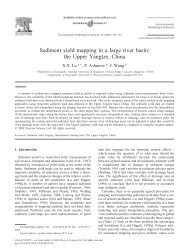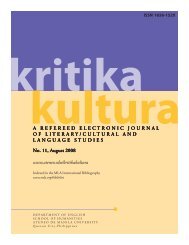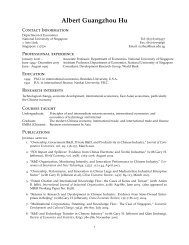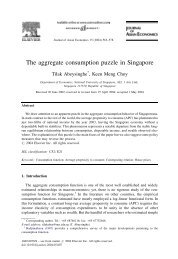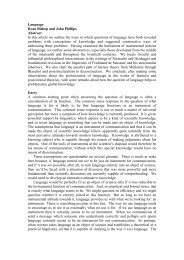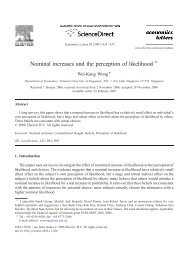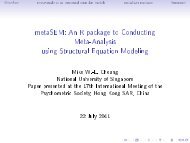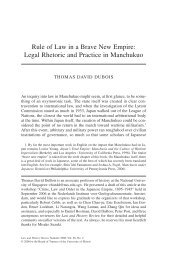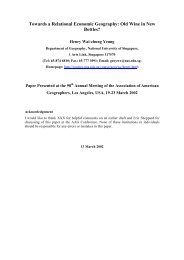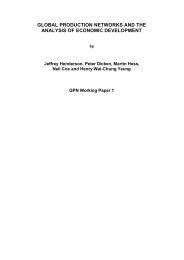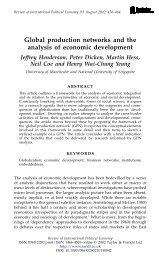Researching Hybridity in Social and Economic ... - NUS Home
Researching Hybridity in Social and Economic ... - NUS Home
Researching Hybridity in Social and Economic ... - NUS Home
Create successful ePaper yourself
Turn your PDF publications into a flip-book with our unique Google optimized e-Paper software.
<strong>Research<strong>in</strong>g</strong> <strong>Hybridity</strong> <strong>in</strong> <strong>Social</strong> <strong>and</strong> <strong>Economic</strong><br />
Geography: The Case of ‘Ch<strong>in</strong>ese’ Bus<strong>in</strong>ess Networks<br />
Henry Wai-chung Yeung<br />
Associate Professor, Department of Geography, National University of S<strong>in</strong>gapore,<br />
1 Arts L<strong>in</strong>k, S<strong>in</strong>gapore 117570<br />
(Tel: 65-6874 6810; Fax: 65-6777 3091; Email: HenryYeung@nus.edu.sg;<br />
<strong>Home</strong>page: http://courses.nus.edu.sg/course/geoywc/henry.htm)<br />
A Keynote Paper Presented at the Annual Meet<strong>in</strong>g of F<strong>in</strong>nish Geographers<br />
<strong>in</strong> Joensuu, F<strong>in</strong>l<strong>and</strong>, 11-13 November 2004<br />
About the Speaker<br />
Henry Wai-chung Yeung has been Associate Professor <strong>in</strong> <strong>Economic</strong> Geography at the<br />
Department of Geography, National University of S<strong>in</strong>gapore s<strong>in</strong>ce January 2000. He was a<br />
recipient of the Commonwealth Fellowship <strong>and</strong> the Fulbright Foreign Research Award. His<br />
research <strong>in</strong>terests cover broadly theories <strong>and</strong> the geography of transnational corporations,<br />
Asian firms <strong>and</strong> their overseas operations <strong>and</strong> Ch<strong>in</strong>ese bus<strong>in</strong>ess networks <strong>in</strong> the Asia-Pacific<br />
region. Professor Yeung has published widely on transnational corporations from develop<strong>in</strong>g<br />
countries, <strong>in</strong> particular Hong Kong, S<strong>in</strong>gapore <strong>and</strong> other Asian Newly Industrialized<br />
Economies. He is the author of Transnational Corporations <strong>and</strong> Bus<strong>in</strong>ess Networks<br />
(Routledge, London, 1998), Entrepreneurship <strong>and</strong> the Internationalisation of Asian Firms<br />
(Edward Elgar, Cheltenham, 2002), <strong>and</strong> Ch<strong>in</strong>ese Capitalism <strong>in</strong> a Global Era (Routledge,<br />
London, 2004). He is also the editor of The Globalisation of Bus<strong>in</strong>ess Firms from Emerg<strong>in</strong>g<br />
Markets, Two Volumes (Edward Elgar, Cheltenham, 1999) <strong>and</strong> co-editor of Globalisation<br />
<strong>and</strong> the Asia Pacific (Routledge, London, 1999), Globalization of Ch<strong>in</strong>ese Bus<strong>in</strong>ess Firms<br />
(Macmillan, New York, 2000), Remak<strong>in</strong>g the Global Economy (Sage, London, 2003). He has<br />
over 60 research papers published <strong>in</strong> <strong>in</strong>ternationally refereed journals <strong>and</strong> 20 chapters <strong>in</strong><br />
books. He is Editor of Environment <strong>and</strong> Plann<strong>in</strong>g A, <strong>Economic</strong> Geography, <strong>and</strong> Review of<br />
International Political Economy, Asia-Pacific Editor of Global Networks, <strong>and</strong> Bus<strong>in</strong>ess<br />
Manager of S<strong>in</strong>gapore Journal of Tropical Geography. He sits on the editorial boards of 7<br />
other <strong>in</strong>ternational journals, <strong>in</strong>clud<strong>in</strong>g Asia Pacific Journal of Management, European Urban<br />
<strong>and</strong> Regional Studies, <strong>and</strong> Journal of <strong>Economic</strong> Geography. From 2003-2005, he is the East<br />
Asia Director, Asia Specialty Group of the Association of American Geographers. He is also<br />
the Southeast Asia Representative <strong>in</strong> the Commonwealth Geographical Bureau Management<br />
Committee, 2001-2008.<br />
Acknowledgement<br />
I would like to thank Markku Tykkylä<strong>in</strong>en <strong>and</strong> the Geographical Society of F<strong>in</strong>l<strong>and</strong> for<br />
<strong>in</strong>vit<strong>in</strong>g me to deliver this presentation. Trevor Barnes has offered some very <strong>in</strong>sightful<br />
comments on an earlier draft of this paper. I am solely responsible for the content of this<br />
paper.<br />
16 November 2004
<strong>Research<strong>in</strong>g</strong> <strong>Hybridity</strong> <strong>in</strong> <strong>Social</strong> <strong>and</strong> <strong>Economic</strong><br />
Geography: The Case of ‘Ch<strong>in</strong>ese’ Bus<strong>in</strong>ess Networks<br />
Abstract<br />
The concept hybridity has posed a very significant methodological challenge to our practice<br />
as social <strong>and</strong> economic geographers. While economic organizations are <strong>in</strong>creas<strong>in</strong>gly<br />
hybridized through such non-economic forces as social embeddedness <strong>and</strong> cultural identities,<br />
conventional methods <strong>and</strong> techniques <strong>in</strong> social <strong>and</strong> economic geography seem to fail to<br />
capture this process of hybridization <strong>and</strong> its complex geographies. In this reflexive paper, I<br />
am to discuss how a process-based methodology <strong>in</strong>corporat<strong>in</strong>g some elements of actornetwork<br />
analysis may contribute to resolv<strong>in</strong>g this complicated issue of research<strong>in</strong>g <strong>in</strong>to the<br />
hybridity of economic organizations. Reflect<strong>in</strong>g on my own experience of research<strong>in</strong>g<br />
Ch<strong>in</strong>ese capitalism, I show how this process-based methodology is useful <strong>in</strong> unravel<strong>in</strong>g the<br />
complex <strong>and</strong> often secretive nature of the spatial organization of Ch<strong>in</strong>ese family firms <strong>and</strong><br />
their bus<strong>in</strong>ess networks <strong>in</strong> East <strong>and</strong> Southeast Asia. The cultural identities <strong>and</strong> spatiality of<br />
key actors <strong>in</strong> these Ch<strong>in</strong>ese bus<strong>in</strong>ess networks are <strong>in</strong>creas<strong>in</strong>gly heterogeneous such that it<br />
becomes rather difficult to identify purely “Ch<strong>in</strong>ese” actors <strong>in</strong> today’s globaliz<strong>in</strong>g era. As<br />
such, the emergence of a new hybrid form of “Ch<strong>in</strong>ese” bus<strong>in</strong>ess networks entails a<br />
reconsideration of our exist<strong>in</strong>g research methods <strong>and</strong> practices. In so do<strong>in</strong>g, I also exam<strong>in</strong>e the<br />
wider issue about the politics <strong>and</strong> practice of research<strong>in</strong>g hybridity <strong>in</strong> social <strong>and</strong> economic<br />
geography.<br />
Reflect<strong>in</strong>g on the culturalist perspective of Ch<strong>in</strong>ese capitalism<br />
In this paper, I aim to reflect critically on my own posititonality <strong>in</strong> research<strong>in</strong>g<br />
hybridity <strong>in</strong> Ch<strong>in</strong>ese bus<strong>in</strong>ess networks <strong>and</strong> to problematize methodologically Ch<strong>in</strong>ese<br />
capitalism research. This methodological paper is <strong>in</strong>tentionally reflexive <strong>and</strong> is thus peculiar<br />
to my own experience of research<strong>in</strong>g Ch<strong>in</strong>ese capitalism. Ch<strong>in</strong>ese capitalism can be def<strong>in</strong>ed<br />
as a historically- <strong>and</strong> geographically-specific form of economic organization among ethnic<br />
Ch<strong>in</strong>ese liv<strong>in</strong>g outside ma<strong>in</strong>l<strong>and</strong> Ch<strong>in</strong>a, particularly <strong>in</strong> East <strong>and</strong> Southeast Asia. It is a<br />
dom<strong>in</strong>ant mode of economic organization <strong>in</strong> East <strong>and</strong> Southeast Asia because of not only its<br />
economic significance <strong>in</strong> the host economies, but also its complex <strong>and</strong>, yet, <strong>in</strong>tricate social<br />
organization <strong>and</strong> authority systems (see Yeung, 2004a). To put the logic of my presentation<br />
upfront, I will show how my methodological approach to research<strong>in</strong>g Ch<strong>in</strong>ese capitalism has<br />
shifted over the years from a static culturalist one to a dynamic transformative perspective.<br />
2
This significant shift <strong>in</strong> my own research methodology is attributed largely to my grow<strong>in</strong>g<br />
awareness of my positionality as an ethnic Ch<strong>in</strong>ese research<strong>in</strong>g Ch<strong>in</strong>ese capitalism <strong>and</strong> the<br />
dynamic transformations <strong>in</strong> Ch<strong>in</strong>ese capitalism <strong>in</strong> relation to globalization tendencies. In other<br />
words, my perspective on Ch<strong>in</strong>ese capitalism changes <strong>in</strong> relation to critical reflections on my<br />
research positionality <strong>and</strong> the material processes that <strong>in</strong>creas<strong>in</strong>gly hybridize Ch<strong>in</strong>ese<br />
capitalism <strong>in</strong> a global era.<br />
To beg<strong>in</strong>, I want to offer a confession about my own positionality <strong>in</strong> the ten-year<br />
course of produc<strong>in</strong>g all those published texts on Ch<strong>in</strong>ese capitalism. Know<strong>in</strong>gly or not, these<br />
texts are part <strong>and</strong> parcel of the wider actor networks that may shape the transformations <strong>in</strong><br />
Ch<strong>in</strong>ese capitalism. In particular, all those exchanges of perspectives dur<strong>in</strong>g my <strong>in</strong>terviews<br />
with key actors <strong>in</strong> Ch<strong>in</strong>ese family firms, my <strong>in</strong>teractions with lead<strong>in</strong>g experts <strong>in</strong> academic<br />
workshops <strong>and</strong> conferences <strong>and</strong> readers of my published work would have produced<br />
un<strong>in</strong>tended effects on Ch<strong>in</strong>ese capitalism. When I first embarked on my research <strong>and</strong> writ<strong>in</strong>g<br />
as a half-baked “culturalist” <strong>in</strong> the early 1990s, I was naïve enough to believe unquestionably<br />
<strong>in</strong> the <strong>in</strong>tr<strong>in</strong>sic importance of guanxi or social relationships <strong>in</strong> expla<strong>in</strong><strong>in</strong>g the economic<br />
organization of Ch<strong>in</strong>ese capitalism. A “culturalist” is simply someone who deploys culture to<br />
expla<strong>in</strong> all forms of economic action <strong>and</strong> outcomes. As a firm believer <strong>in</strong> the role of culture<br />
then, I saw the Ch<strong>in</strong>ese cultural trait of guanxi as essentially shap<strong>in</strong>g the behaviour <strong>and</strong><br />
activities of ethnic Ch<strong>in</strong>ese bus<strong>in</strong>ess firms. While my fasc<strong>in</strong>ation with culture <strong>and</strong> ethnicity <strong>in</strong><br />
shap<strong>in</strong>g economic organizations predates the “cultural turn” <strong>in</strong> economic geography (see<br />
Thrift <strong>and</strong> Olds, 1996; Lee <strong>and</strong> Wills, 1997; Barnett, 1998; Barnes, 2001), what I did not<br />
realize at the time was that I was <strong>in</strong>deed substitut<strong>in</strong>g one form of (economic) essentialism<br />
with another – cultural essentialism. In retrospect, my false beliefs <strong>in</strong> the “culturalist”<br />
perspective on Ch<strong>in</strong>ese capitalism had much to do with my positionality as an ethnic Ch<strong>in</strong>ese<br />
born <strong>in</strong> ma<strong>in</strong>l<strong>and</strong> Ch<strong>in</strong>a <strong>and</strong> as a citizen <strong>in</strong> a predom<strong>in</strong>antly ethnic Ch<strong>in</strong>ese economy<br />
3
(S<strong>in</strong>gapore) <strong>and</strong> a permanent resident <strong>in</strong> another under the authority of the People’s Republic<br />
of Ch<strong>in</strong>a (Hong Kong SAR). I thought I was gifted with “<strong>in</strong>sider” knowledge of the <strong>in</strong>tr<strong>in</strong>sic<br />
operations of Ch<strong>in</strong>ese capitalism. But I was unaware of the <strong>in</strong>herent danger <strong>and</strong> bias <strong>in</strong> my<br />
taken-for-granted positionality as an ethnic Ch<strong>in</strong>ese research<strong>in</strong>g the role of Ch<strong>in</strong>ese culture <strong>in</strong><br />
shap<strong>in</strong>g the economic organization of ethnic Ch<strong>in</strong>ese bus<strong>in</strong>ess firms. As the famous Ch<strong>in</strong>ese<br />
say<strong>in</strong>g goes, an <strong>in</strong>sider is so obsessed with the phenomenon that it takes an outsider to tell a<br />
better picture.<br />
When I began my research <strong>in</strong> ethnic Ch<strong>in</strong>ese entrepreneurs from Hong Kong <strong>in</strong> 1993,<br />
I was attracted to popular writ<strong>in</strong>gs about Ch<strong>in</strong>ese capitalism (wrongly called “Overseas<br />
Ch<strong>in</strong>ese bus<strong>in</strong>ess” <strong>in</strong> many <strong>in</strong>stances). In retrospect, they were not anyth<strong>in</strong>g more than ethnic<br />
stereotypes or, worst, racist caricatures. In this vast literature mushroom<strong>in</strong>g dur<strong>in</strong>g the late<br />
1980s <strong>and</strong> the early 1990s, Ch<strong>in</strong>ese culture <strong>and</strong> guanxi networks were celebrated as the<br />
fundamental reason for the success of lead<strong>in</strong>g Ch<strong>in</strong>ese entrepreneurs <strong>and</strong> their bus<strong>in</strong>ess<br />
conglomerates <strong>in</strong> the Asia Pacific region. The popularity <strong>and</strong> prom<strong>in</strong>ence of such a<br />
triumphant characterization of Ch<strong>in</strong>ese capitalism as “bamboo networks”, “guanxi capitalism”<br />
or “Confucian capitalism” perpetuated an essentialist argument that all ethnic Ch<strong>in</strong>ese <strong>in</strong> East<br />
<strong>and</strong> Southeast Asia share similar Confucian worldviews. 1 In this “culturalist” literature, the<br />
Ch<strong>in</strong>ese Confucian culture was taken for granted as someth<strong>in</strong>g both presuppos<strong>in</strong>g the<br />
economic success of “Overseas Ch<strong>in</strong>ese” <strong>and</strong> def<strong>in</strong><strong>in</strong>g the “spirit of Ch<strong>in</strong>ese capitalism” <strong>in</strong><br />
the same way as how Weber [1930] (1992) used the Protestant ethic to def<strong>in</strong>e the cultural<br />
essence of Western capitalism. Def<strong>in</strong>ed then as an endur<strong>in</strong>g cultural system of economic<br />
activities, Ch<strong>in</strong>ese capitalism was therefore seen as static <strong>and</strong> self-conta<strong>in</strong>ed with<strong>in</strong> peculiar<br />
social <strong>and</strong> political contexts <strong>in</strong> East <strong>and</strong> Southeast Asia. It was not subject to any significant<br />
degree of change <strong>and</strong> transformation because of the endur<strong>in</strong>g effects of cultural impr<strong>in</strong>ts on its<br />
economic organization – primarily evident through the pervasive presence of the Ch<strong>in</strong>ese<br />
4
family firm. Prompted by these celebratory read<strong>in</strong>gs on Ch<strong>in</strong>ese capitalism dur<strong>in</strong>g the late<br />
1980s <strong>and</strong> early 1990s 2 <strong>and</strong> the lack of critical work <strong>in</strong> economic geography, much of my<br />
early research perspective was misplaced <strong>in</strong> unpack<strong>in</strong>g Ch<strong>in</strong>ese bus<strong>in</strong>ess activities from such<br />
a culturally <strong>in</strong>spired position. In short, I fell prey to such a triumphant <strong>and</strong> dom<strong>in</strong>ant discourse<br />
that permeated much of East Asian studies at the time (see critique <strong>in</strong> Berger <strong>and</strong> Borer, 1997;<br />
Ong <strong>and</strong> Non<strong>in</strong>i, 1997).<br />
Dur<strong>in</strong>g the same period, social <strong>and</strong> economic geography witnessed the rapid<br />
emergence of “social embeddedness”, a Polanyian concept popularized by economic<br />
sociologist Mark Granovetter (1985). It became a key concept <strong>in</strong> refigur<strong>in</strong>g the economic <strong>in</strong><br />
economic geography (see Dicken <strong>and</strong> Thrift, 1992; Thrift <strong>and</strong> Olds, 1996; Hess, 2004). In this<br />
view, the social embeddedness of economic action tends to take a methodological precedence<br />
over <strong>and</strong> above the dynamic process of disembedd<strong>in</strong>g. While it represents a tell<strong>in</strong>g move<br />
away from neoclassical economic th<strong>in</strong>k<strong>in</strong>g, the social embeddedness perspective rema<strong>in</strong>s as a<br />
form of “structuralist” th<strong>in</strong>k<strong>in</strong>g through a peculiar way <strong>in</strong> which economic processes are<br />
understood as <strong>in</strong>separable from <strong>and</strong> thus embedded <strong>in</strong> preexist<strong>in</strong>g structures of social <strong>and</strong><br />
cultural networks. I brief, embeddedness is viewed as a static property that is possessed <strong>and</strong><br />
dispossessed by social actors. Empirically, it became so natural to me that the economic<br />
action of Ch<strong>in</strong>ese bus<strong>in</strong>ess firms must be socially embedded <strong>in</strong> dense networks of guanxi or<br />
personal relationships throughout East <strong>and</strong> Southeast Asia. More crucially, I was so<br />
determ<strong>in</strong>ed methodologically to look out consciously for the “embeddedness variable” <strong>in</strong> my<br />
early empirical study of Hong Kong <strong>in</strong>vestments <strong>in</strong> Southeast Asia (see Yeung, 1997a;<br />
1997b). In so do<strong>in</strong>g, I focused narrowly on the cultural embedd<strong>in</strong>g of ethnic Ch<strong>in</strong>ese<br />
economic activities <strong>and</strong> failed to notice the important underly<strong>in</strong>g transformations <strong>and</strong><br />
disembedd<strong>in</strong>g processes tak<strong>in</strong>g place <strong>in</strong> the socio-economic (re)organization of Ch<strong>in</strong>ese<br />
5
capitalism. In particular, I went <strong>in</strong>to the field with the firm belief that Ch<strong>in</strong>ese capitalism must<br />
be all about ethnic Ch<strong>in</strong>ese <strong>and</strong> their cultural beliefs that drive the economic system.<br />
At both theoretical <strong>and</strong> methodological levels, I paid no attention or whatsoever to the<br />
possibilities of non-Ch<strong>in</strong>ese (e.g. foreign partners, <strong>in</strong>stitutional <strong>in</strong>vestors <strong>and</strong> <strong>in</strong>ternational<br />
media commentators) as important actors <strong>in</strong> shap<strong>in</strong>g the nature <strong>and</strong> organization of Ch<strong>in</strong>ese<br />
capitalism – a process of hybridization that becomes apparent to me at a much later stage of<br />
my research project. To sum up the earlier phase of my research <strong>in</strong>to Ch<strong>in</strong>ese capitalism, I<br />
was mostly driven by the culturalist-<strong>in</strong>spired perspective on Ch<strong>in</strong>ese bus<strong>in</strong>ess firms <strong>and</strong> a<br />
research methodology attuned to discover<strong>in</strong>g cultural convergence <strong>and</strong> structural relations of<br />
embeddedness rather than dynamic change <strong>and</strong> transformations <strong>in</strong> relation to globalization<br />
tendencies. The end result of this self-imposed “lock-<strong>in</strong>” trajectory <strong>in</strong> my research practice is<br />
the production of a series of texts that celebrated the importance of guanxi <strong>and</strong> personal<br />
relationships <strong>in</strong> expla<strong>in</strong><strong>in</strong>g the transnational bus<strong>in</strong>ess networks of Ch<strong>in</strong>ese bus<strong>in</strong>ess firms<br />
from Hong Kong (see Yeung, 1997a; 1997b; 1998). In a methodological sense, this is a case<br />
of you see only what you want to see <strong>and</strong> therefore preclude other possibilities (e.g.<br />
divergence <strong>and</strong> change). I did manage to show how ethnicity <strong>and</strong> social embeddedness matter<br />
<strong>in</strong> the transnational organization of Ch<strong>in</strong>ese bus<strong>in</strong>ess networks. But <strong>in</strong> reproduc<strong>in</strong>g these<br />
“culturalist” explanations of convergence <strong>in</strong> Ch<strong>in</strong>ese capitalism, I failed to shed light on the<br />
dynamic transformations of Ch<strong>in</strong>ese capitalism <strong>in</strong> a global era.<br />
Reposition<strong>in</strong>g my Ch<strong>in</strong>ese capitalism research: What has culture got to do with it?<br />
By the late 1990s <strong>and</strong> <strong>in</strong> the aftermath of the 1997/1998 Asian economic crisis, I<br />
became much more aware of my own positionality with<strong>in</strong> Ch<strong>in</strong>ese capitalism research.<br />
Hav<strong>in</strong>g been <strong>in</strong>vited to numerous workshops <strong>and</strong> conferences on Ch<strong>in</strong>ese bus<strong>in</strong>ess <strong>in</strong> Asia<br />
<strong>and</strong> Europe, I realized that I was more than just an academic researcher who produces<br />
knowledge on Ch<strong>in</strong>ese capitalism. Indeed, my research “f<strong>in</strong>d<strong>in</strong>gs” must have a much wider<br />
6
impact on the very subjects of research themselves. A special report on Asian family<br />
succession by John Ridd<strong>in</strong>g, a Hong Kong-based correspondent of The F<strong>in</strong>ancial Times, on<br />
10 March 1998 quoted me, among other th<strong>in</strong>gs, as say<strong>in</strong>g, “Even if you have a good son, it is<br />
difficult for him to comm<strong>and</strong> the respect accorded to [the] founder <strong>and</strong> patriarch” <strong>and</strong>, “For<br />
many <strong>in</strong>ternational <strong>in</strong>vestors the lack of transparency is l<strong>in</strong>ked to family control <strong>and</strong><br />
succession” (p.15). Be<strong>in</strong>g quoted as a Ch<strong>in</strong>ese bus<strong>in</strong>ess expert <strong>in</strong> one of the world’s most<br />
famous bus<strong>in</strong>ess newspapers apparently opened many more doors for me. The Far Eastern<br />
<strong>Economic</strong> Review subsequently approached me for an exclusive <strong>in</strong>terview on “succession <strong>in</strong><br />
Ch<strong>in</strong>ese family bus<strong>in</strong>ess” that was also aired live on CNBC Live shortly after the FT report.<br />
This totally unexpected coverage of my views on Ch<strong>in</strong>ese family bus<strong>in</strong>ess by three<br />
highly <strong>in</strong>fluential media products (FT, FEER <strong>and</strong> CNBC) made me aware for the first time<br />
that academics could be an important actant, <strong>in</strong> the words of actor network theory, <strong>in</strong> shap<strong>in</strong>g<br />
the ways <strong>in</strong> which the bus<strong>in</strong>ess community operates. I was quite sure that the impact of my<br />
comments on the bus<strong>in</strong>ess community was further enhanced by the ongo<strong>in</strong>g <strong>and</strong> unruly<br />
accusation of “crony capitalism” <strong>in</strong> the wake of the Asian economic crisis. Such lead<strong>in</strong>g<br />
commentators of the Asian economic crisis <strong>in</strong> 1997/1998 as Paul Krugman <strong>and</strong> Alan<br />
Greespan had argued that the crisis resulted from the lack of transparency <strong>in</strong> the f<strong>in</strong>ancial<br />
systems of various Asian economies. In many East <strong>and</strong> Southeast Asian economies, the<br />
existence of strong patron-client relationships between the state <strong>and</strong> bus<strong>in</strong>ess people (mostly<br />
ethnic Ch<strong>in</strong>ese) was suggested as the primary cause of the Asian economic crisis. The deep<br />
cultural roots <strong>in</strong> Confucianism of this k<strong>in</strong>d of “crony capitalism” were revealed as someth<strong>in</strong>g<br />
highly negative <strong>and</strong> detrimental to the efficient operation of the market mechanism <strong>in</strong> East<br />
<strong>and</strong> Southeast Asia, culm<strong>in</strong>at<strong>in</strong>g <strong>in</strong> the economic crisis. My suggestion of the l<strong>in</strong>k between<br />
family control <strong>and</strong> the lack of transparency <strong>in</strong> Ch<strong>in</strong>ese family firms published <strong>in</strong> The<br />
F<strong>in</strong>ancial Times couldn’t be timelier! It must have been picked up by some high profile<br />
7
eaders <strong>in</strong> bus<strong>in</strong>ess <strong>and</strong> government to support their view of “crony capitalism” <strong>in</strong> East <strong>and</strong><br />
Southeast Asia.<br />
After this series of media exposures, it was clear that I needed to question my own<br />
positionality <strong>in</strong> this project on Ch<strong>in</strong>ese capitalism. This was partly because of my read<strong>in</strong>g <strong>in</strong>to<br />
poststructuralist work <strong>in</strong> human geography published at around the same time (Gibson-<br />
Graham, 1996; Thrift, 1996; Rose, 1997) <strong>and</strong> partly because of my <strong>in</strong>creas<strong>in</strong>g awareness of<br />
the potential “global” reach <strong>and</strong> impact of my research work. I came to realize how my own<br />
positionality might have shaped my research agenda <strong>and</strong> the un<strong>in</strong>tended ways through which I<br />
communicated my research f<strong>in</strong>d<strong>in</strong>gs to the wider audience (e.g. media <strong>and</strong> professional<br />
publications). 3 I thought that as an ethnic Ch<strong>in</strong>ese researcher speak<strong>in</strong>g on the perils of<br />
“Ch<strong>in</strong>ese capitalism”, my words might be construed <strong>and</strong> received rather differently (<strong>and</strong><br />
positively?) than those from such “essential outsiders” as Anglo-American scholars. I<br />
wondered whether I became part of the alleged “Western conspiracy” that, accord<strong>in</strong>g to the<br />
former Prime M<strong>in</strong>ister of Malaysia – Dr Mahathir Mohamed, brought the crisis to Asia. I<br />
began to question my own ethnic <strong>and</strong> cultural identity as an “Overseas Ch<strong>in</strong>ese” – overseas to<br />
where <strong>and</strong> what? Am I a believer <strong>in</strong> Confucianism <strong>and</strong> guanxi capitalism? Do I know <strong>and</strong><br />
practice guanxi as all ethnic Ch<strong>in</strong>ese are allegedly expected to do? What about the Italians <strong>and</strong><br />
the Jews or Anglos, doesn’t their form of economic activity rest on embedded relations even<br />
though it is not called “guanxi”? So the story <strong>and</strong> its mischief <strong>in</strong> justify<strong>in</strong>g the allegation of<br />
“crony capitalism” <strong>in</strong> Asia goes on <strong>and</strong> on <strong>in</strong> these cultural essentialist writ<strong>in</strong>gs. I began to<br />
lose faith <strong>in</strong> the culturalist perspective <strong>and</strong> went on to search for an alternative approach to<br />
study Ch<strong>in</strong>ese capitalism.<br />
Why was there a u-turn <strong>in</strong> my approach to Ch<strong>in</strong>ese capitalism? Dur<strong>in</strong>g the course of<br />
this decade-long research <strong>in</strong>to Ch<strong>in</strong>ese capitalism, what has apparently changed <strong>in</strong> me is not<br />
the subject of my <strong>in</strong>tellectual pursuit (although how I see that subject has changed), but rather<br />
8
my th<strong>in</strong>k<strong>in</strong>g becom<strong>in</strong>g more reflexive <strong>and</strong> my reason<strong>in</strong>g about it becom<strong>in</strong>g less culturalist <strong>and</strong><br />
more transformative. While the change <strong>in</strong> my views on Ch<strong>in</strong>ese capitalism has a lot to do with<br />
my grow<strong>in</strong>g reflexivity <strong>in</strong> an <strong>in</strong>tellectual sense, it is also positively correlated with the<br />
dramatic pace at which globalization tendencies have transformed the world economy <strong>and</strong> the<br />
dynamic <strong>in</strong>tegration of Ch<strong>in</strong>ese capitalism <strong>in</strong>to these tendencies (as suppliers, strategic<br />
partners, <strong>and</strong> competitors). Just as reflexivity <strong>in</strong> my own positionality has changed my<br />
worldviews, there is a concomitant shift <strong>in</strong> the nature <strong>and</strong> economic organization of Ch<strong>in</strong>ese<br />
capitalism <strong>in</strong> association with the globalization of economic activities. 4 And it is this story of<br />
change <strong>and</strong> transformation <strong>in</strong> Ch<strong>in</strong>ese capitalism that underscores much of the concept<br />
hybridity. To me, Ch<strong>in</strong>ese capitalism does not exist as a “pure” form of capitalism because it<br />
evolves over time just like its Anglo-American, German <strong>and</strong> Japanese counterparts. Instead, it<br />
is a form of hybrid capitalism that is def<strong>in</strong>ed by its <strong>in</strong>complete, partial <strong>and</strong> cont<strong>in</strong>gent<br />
transformations towards an evolv<strong>in</strong>g set of capitalist norms, <strong>in</strong>stitutions <strong>and</strong> structures. We<br />
are <strong>in</strong>deed beg<strong>in</strong>n<strong>in</strong>g to witness the rise of a peculiar mode of hybrid capitalism characterized<br />
by the <strong>in</strong>fusion of a variety of disembedd<strong>in</strong>g economic logics <strong>and</strong> social organizations that<br />
defy easy identification <strong>and</strong> simple analysis. The very transformative nature of hybrid<br />
capitalism implies that there is no def<strong>in</strong>ite end-state <strong>and</strong> form because political <strong>and</strong> economic<br />
outcomes of transition depend very much on complex <strong>in</strong>teractions among social actors <strong>and</strong><br />
their embedded <strong>in</strong>stitutions. The territorial unboundedness of Ch<strong>in</strong>ese capitalism with<strong>in</strong><br />
dist<strong>in</strong>ctive national economies also contributes to its emergent hybridity because multiple<br />
forces <strong>and</strong> condition<strong>in</strong>g factors shap<strong>in</strong>g its structures <strong>and</strong> trajectories at the supra-national<br />
scale are at work. Put it rather crudely, much of Ch<strong>in</strong>ese capitalism today is like a banana –<br />
yellow outside <strong>and</strong> white <strong>in</strong>side. There is a curious mixture <strong>and</strong> juxtaposition of traditional<br />
Ch<strong>in</strong>ese practices <strong>and</strong> established norms <strong>and</strong> conventions <strong>in</strong> global capitalism (see more<br />
empirical analysis <strong>in</strong> Yeung, 2004a; see also Ong <strong>and</strong> Non<strong>in</strong>i, 1997; Gomez <strong>and</strong> Hsiao, 2004).<br />
9
My argument on Ch<strong>in</strong>ese capitalism thus complements Hamilton’s (1999: 4) idea that<br />
“capitalism is not a stable <strong>and</strong> readily identifiable configuration that, like a flower, suddenly<br />
bursts forth <strong>in</strong> bloom. Instead, capitalism is merely a term that covers an extremely wide<br />
range of diverse economic activities organized <strong>in</strong> the context of competitive markets <strong>and</strong><br />
whose <strong>in</strong>stitutional conditions <strong>in</strong>clude private ownership <strong>and</strong> non-state decision mak<strong>in</strong>g”. It<br />
also supports Storper <strong>and</strong> Salais’s (1997) idea of the economy as a hybrid object constituted<br />
through a diversity of conventions <strong>and</strong> worlds of production <strong>in</strong> which actors organize <strong>and</strong><br />
legitimize their action <strong>and</strong> behaviour. The concept of culture <strong>in</strong> Ch<strong>in</strong>ese capitalism, for<br />
example, needs to be reconceptualized as a repertoire of historically cont<strong>in</strong>gent <strong>and</strong><br />
geographically specific practices that respond <strong>and</strong> adapt to chang<strong>in</strong>g local, regional <strong>and</strong> global<br />
circumstances rather than as permanently fixed mental <strong>and</strong> organizational structures that resist<br />
challenges <strong>and</strong> pressures to change (see also Hwang, 1987; Yang, 1994; 2002). Largely due to<br />
this reflexive th<strong>in</strong>k<strong>in</strong>g on the “culturalist” perspective on Ch<strong>in</strong>ese capitalism, my recent<br />
theoretical <strong>and</strong> empirical research has focused on how Ch<strong>in</strong>ese capitalism <strong>and</strong> its core feature<br />
– the Ch<strong>in</strong>ese family firm <strong>and</strong> its bus<strong>in</strong>ess networks – may change <strong>and</strong> evolve, <strong>and</strong> what<br />
accounts for the underly<strong>in</strong>g processes of these changes.<br />
This more dynamic approach is necessary because Ch<strong>in</strong>ese capitalism is not a k<strong>in</strong>d of<br />
cultural artefact that is forever cast <strong>in</strong> stones. Rather, Ch<strong>in</strong>ese capitalism is lived as a peculiar<br />
set of spatial-temporal outcomes, is highly <strong>in</strong>stitutionalized, <strong>and</strong> consists of immense<br />
struggles <strong>and</strong> contestations by social actors through discursive strategies <strong>and</strong> material<br />
practices (of which I seem<strong>in</strong>gly play a small role through my research <strong>and</strong> writ<strong>in</strong>gs).<br />
<strong>Research<strong>in</strong>g</strong> the transformative processes of Ch<strong>in</strong>ese capitalism, I have realized the<br />
importance of focus<strong>in</strong>g on these key social actors. This approach requires us to focus not so<br />
much on the cultural systems of beliefs <strong>and</strong> values <strong>in</strong> Ch<strong>in</strong>ese capitalism, but rather on how<br />
key actors perform their social <strong>and</strong> economic imperatives <strong>in</strong> real life such that their collective<br />
10
action could br<strong>in</strong>g about changes <strong>and</strong> transformations <strong>in</strong> the broader structures of Ch<strong>in</strong>ese<br />
capitalism. Tak<strong>in</strong>g such an actor-oriented approach, however, should not be about throw<strong>in</strong>g<br />
“culture” (the baby) out with the popular writ<strong>in</strong>gs on the “Overseas Ch<strong>in</strong>ese bus<strong>in</strong>ess” (the<br />
bathwater). It is <strong>in</strong>stead about see<strong>in</strong>g culture as a set of practices that change with<br />
circumstances <strong>and</strong> contexts <strong>and</strong> about pay<strong>in</strong>g more attention to social actors <strong>in</strong> enabl<strong>in</strong>g this<br />
change <strong>and</strong> transformation. By re<strong>in</strong>terpret<strong>in</strong>g <strong>and</strong> retheoriz<strong>in</strong>g its dynamics <strong>in</strong> a global era, I<br />
believe Ch<strong>in</strong>ese capitalism is <strong>in</strong>creas<strong>in</strong>gly becom<strong>in</strong>g a form of hybrid capitalism that reflects<br />
both the <strong>in</strong>fluence of globalization tendencies on nationally or supra-nationally organized<br />
economic systems <strong>and</strong> the impact of significant participation of key actors from those<br />
economic systems <strong>in</strong> globalization tendencies (see Yeung, 2000). As a form of hybrid<br />
capitalism, Ch<strong>in</strong>ese capitalism embodies the <strong>in</strong>terpenetration of culturally <strong>and</strong> <strong>in</strong>stitutionally<br />
specific dynamics at the local <strong>and</strong> regional scales, <strong>and</strong> the grow<strong>in</strong>g <strong>in</strong>fluence of flows of<br />
people, capital, technology <strong>and</strong> knowledge on the global scale.<br />
Problematiz<strong>in</strong>g Ch<strong>in</strong>ese capitalism research<br />
Hav<strong>in</strong>g clarified my positionality <strong>and</strong> chang<strong>in</strong>g conceptions of the nature <strong>and</strong><br />
organization of Ch<strong>in</strong>ese capitalism, I want to devote the rest of this paper to discuss<strong>in</strong>g how<br />
the politics <strong>and</strong> practice of my research are shaped throughout my decade-long project on<br />
Ch<strong>in</strong>ese capitalism. Elsewhere <strong>in</strong> Yeung (2003), I discussed a process-based methodological<br />
framework for underst<strong>and</strong><strong>in</strong>g the practice of new economic geographies. In this framework, I<br />
argued for special attention to four different moments of the research process: (1) the use of<br />
primary <strong>and</strong> secondary data; (2) the need to trace cha<strong>in</strong>s <strong>and</strong> networks; (3) the role of <strong>in</strong> situ<br />
research <strong>and</strong> (4) the generation of theoretical <strong>in</strong>sights. Figure 1 provides a convenient<br />
summary of how these different moments of the methodological framework fit with<strong>in</strong> my<br />
research of Ch<strong>in</strong>ese capitalism. While the follow<strong>in</strong>g post-hoc rationalization of my own<br />
research might appear too neat <strong>and</strong> clean, the realities of my research are much messier <strong>and</strong> ad<br />
11
hoc <strong>in</strong> nature. Methodological pragmatism <strong>and</strong> improvisation are my rule of the thumb. To<br />
beg<strong>in</strong>, I th<strong>in</strong>k it is necessary to expla<strong>in</strong> one of the most significant data constra<strong>in</strong>ts of my<br />
project – the secretive nature of Ch<strong>in</strong>ese bus<strong>in</strong>ess. Similar to a number of other m<strong>in</strong>ority<br />
diaspora groups, family bus<strong>in</strong>ess for ethnic Ch<strong>in</strong>ese outside ma<strong>in</strong>l<strong>and</strong> Ch<strong>in</strong>a has a historical<br />
existence of be<strong>in</strong>g a “total <strong>in</strong>stitution” encompass<strong>in</strong>g both cultural <strong>and</strong> economic roles. The<br />
family bus<strong>in</strong>ess serves dual functions – as a provider to the founder <strong>and</strong> (almost always) his<br />
immediate family members, <strong>and</strong> as an employer of his family members <strong>and</strong> trusted<br />
“lieutenants” (Wong, 1988; Redd<strong>in</strong>g, 1990; Brown, 2000). Although Ch<strong>in</strong>ese family bus<strong>in</strong>ess<br />
has experienced some degree of <strong>in</strong>ternal transformation <strong>in</strong> an era of globalization, the<br />
centrality of the family <strong>in</strong> Ch<strong>in</strong>ese bus<strong>in</strong>ess rema<strong>in</strong>s relatively <strong>in</strong>tact.<br />
**************<br />
Figure 1 here<br />
**************<br />
What then expla<strong>in</strong>s the secretive nature of Ch<strong>in</strong>ese family bus<strong>in</strong>ess? First, because of<br />
the central role of the family <strong>in</strong> Ch<strong>in</strong>ese bus<strong>in</strong>ess, there is a significant degree of<br />
<strong>in</strong>ternalization of <strong>in</strong>formation with<strong>in</strong> the family. This results <strong>in</strong> strong cooperation with<strong>in</strong><br />
family groups <strong>and</strong> networks, but fierce competition among different bus<strong>in</strong>ess groups <strong>and</strong><br />
networks. 5 Trust <strong>and</strong> <strong>in</strong>formation are highly important to bus<strong>in</strong>ess success <strong>and</strong> thus normally<br />
only family members are granted exclusive rights to such <strong>in</strong>formation. Second, the host<br />
countries <strong>in</strong> which Ch<strong>in</strong>ese family bus<strong>in</strong>ess operates (e.g. Southeast Asia) tend to be hostile to<br />
this ethnic organization of economic activities for various political <strong>and</strong> <strong>in</strong>stitutional reasons<br />
(Hamilton, 1991; McVey, 1992; Hodder, 1996; Chirot <strong>and</strong> Reid, 1997; Douw et al., 2001).<br />
The <strong>in</strong>ternalization of <strong>in</strong>formation with<strong>in</strong> the family becomes an important mechanism to<br />
protect one’s family <strong>and</strong> bus<strong>in</strong>ess from external threats from local states <strong>and</strong> dom<strong>in</strong>ant ethnic<br />
groups. This m<strong>in</strong>dset among ethnic Ch<strong>in</strong>ese <strong>in</strong> Southeast Asia, for example, has been<br />
12
variously known as “the siege mentality” (Yoshihara, 1988; Redd<strong>in</strong>g, 1990), “the refugee<br />
mentality” (Kotk<strong>in</strong>, 1992), <strong>and</strong> “the trader’s dilemma” (Menkhoff, 1993).<br />
Given this highly secretive nature of Ch<strong>in</strong>ese capitalism <strong>and</strong> its tendency to be<br />
organized around closely-knit networks of family <strong>and</strong> social relations, I encountered<br />
enormous methodological problems <strong>in</strong> underst<strong>and</strong><strong>in</strong>g the material <strong>and</strong> discursive<br />
constructions of these networks <strong>in</strong> their specific time-space contexts. As I have empirically<br />
shown <strong>in</strong> Yeung (2004a), social <strong>and</strong> bus<strong>in</strong>ess networks evolved <strong>in</strong> such f<strong>in</strong>ancial centres as<br />
Hong Kong <strong>and</strong> S<strong>in</strong>gapore are quite different from those <strong>in</strong> such hostile host countries as<br />
Indonesia <strong>and</strong> Malaysia. Early emigrant entrepreneurs also brought with them very different<br />
form of bus<strong>in</strong>ess networks as second or third generation ethnic Ch<strong>in</strong>ese who grew up <strong>in</strong> these<br />
“host” countries. When I set out to research Ch<strong>in</strong>ese bus<strong>in</strong>ess firms from Hong Kong <strong>in</strong> the<br />
early 1990s, there was little that I could draw from the ma<strong>in</strong>stream social <strong>and</strong> economic<br />
geography literature. Much of economic geography dur<strong>in</strong>g the late 1980s <strong>and</strong> early 1990s was<br />
concerned with <strong>in</strong>dustrial districts <strong>and</strong> flexible production systems (see critical reviews <strong>in</strong><br />
Malmberg, 1994; Yeung, 1994). This research focus <strong>in</strong> economic geography was preceded by<br />
an earlier one around the political economy of uneven development <strong>and</strong> <strong>in</strong>dustrial<br />
restructur<strong>in</strong>g (Lever, 1985; Massey <strong>and</strong> Meegan, 1985). In this large body of economic-<br />
geographical literature, the primary methodological focus was the firm <strong>and</strong> its operat<strong>in</strong>g<br />
environment (known as a milieu). With some exceptions (e.g. Camagni, 1991; Dicken <strong>and</strong><br />
Thrift, 1992; Conti, 1993; Cooke <strong>and</strong> Morgan, 1993; Grabher, 1993; Yeung, 1994), much of<br />
economic geography dur<strong>in</strong>g the 1980s <strong>and</strong> the early 1990s emphasised <strong>in</strong>dustrial firms rather<br />
than embedded networks. In both conceptual <strong>and</strong> methodological realms, economic<br />
geographers, then, were much better <strong>in</strong> l<strong>in</strong>k<strong>in</strong>g regional development to firm-specific<br />
activities than <strong>in</strong> unpack<strong>in</strong>g the social-spatial organization of different firms through networks<br />
of <strong>in</strong>tra-firm <strong>and</strong> <strong>in</strong>ter-firm relations. This overt focus on firm-specific <strong>in</strong>dustrial restructur<strong>in</strong>g<br />
13
<strong>and</strong> production systems resulted <strong>in</strong> a k<strong>in</strong>d of economic geography of firms <strong>and</strong> <strong>in</strong>dustries<br />
devoid of social <strong>and</strong> ethnic identities. With h<strong>in</strong>dsight, the economic geography of the 1980s<br />
appears as “cold”, “<strong>in</strong>human”, “productionist”, <strong>and</strong> “economistic”.<br />
Not surpris<strong>in</strong>gly then, I started my research <strong>in</strong>to Ch<strong>in</strong>ese capitalism with bus<strong>in</strong>ess<br />
firms <strong>in</strong> m<strong>in</strong>d, although I discovered shortly afterwards that I had to open the “black box” of<br />
the firm <strong>and</strong> to focus on social actors <strong>in</strong> my analysis of Ch<strong>in</strong>ese capitalism. In methodological<br />
terms, the crucial role of dense <strong>and</strong> <strong>in</strong>tricate webs of networks <strong>and</strong> relationships <strong>in</strong> Ch<strong>in</strong>ese<br />
bus<strong>in</strong>ess created formidable problems for my empirical research. Though not exclusive, these<br />
methodological problems are related to (1) the unit of research; (2) the discursive identity <strong>and</strong><br />
ethnicity of actors; (3) the spatiality of actors, <strong>and</strong> (4) the role of gatekeepers (or<br />
<strong>in</strong>termediaries <strong>in</strong> actor networks). One of the most daunt<strong>in</strong>g methodological issues was<br />
identify<strong>in</strong>g the unit of research <strong>and</strong> analysis. It was a problem because of Ch<strong>in</strong>ese<br />
capitalism’s extensive regional presence throughout Asia, <strong>and</strong> the dist<strong>in</strong>ctive identities<br />
discursively constructed by host countries <strong>and</strong> among the “Overseas Ch<strong>in</strong>ese” themselves (see<br />
Lim <strong>and</strong> Gosl<strong>in</strong>g, 1983; Wang, 1991; Lynn, 1998). Should the focus be on the family, the<br />
family firm, or the entire network? The complex <strong>in</strong>terconnections among these three<br />
categories have methodologically h<strong>and</strong>icapped previous empirical studies of Ch<strong>in</strong>ese<br />
capitalism. These studies focused exclusively either on Ch<strong>in</strong>ese families <strong>and</strong> their social<br />
practices, or took the family firms out of their social <strong>and</strong> <strong>in</strong>stitutional contexts <strong>and</strong> exam<strong>in</strong>ed<br />
the economic organization of these family firms. This “methodological exclusiveness”<br />
impaired much of their analysis because of the <strong>in</strong>ability to exam<strong>in</strong>e the family, the firm, <strong>and</strong><br />
their networks as total <strong>in</strong>stitutions or <strong>in</strong>tegrated complexes <strong>in</strong> Ch<strong>in</strong>ese capitalism. Today, this<br />
methodological problem cont<strong>in</strong>ues to pose serious implications for decid<strong>in</strong>g what constitutes<br />
appropriate data (see Figure 1). Most quantitative data available on Ch<strong>in</strong>ese capitalism refer<br />
to firm establishments <strong>and</strong>, sometimes, their sharehold<strong>in</strong>g <strong>and</strong> management structures (e.g.<br />
14
Carney <strong>and</strong> Gedajlovic, 2002). A straightforward quantitative analysis of Ch<strong>in</strong>ese family<br />
firms is unable to unravel the complex <strong>in</strong>terconnections between the family, the firm, <strong>and</strong><br />
bus<strong>in</strong>ess networks, let alone the material <strong>and</strong> discursive contexts <strong>in</strong> which they are<br />
constructed. Here, my methodological <strong>in</strong>st<strong>in</strong>cts were much <strong>in</strong>fluenced by the methodology of<br />
trac<strong>in</strong>g actor-specific network relations <strong>in</strong> actor network theory – an <strong>in</strong>fluential perspective <strong>in</strong><br />
the study of sociology of science popularized by Michel Callon, Bruno Latour, John Law <strong>and</strong><br />
others (see more methodological discussion on this <strong>in</strong> the next section).<br />
Of course, one might question whether there is anyth<strong>in</strong>g uniquely Ch<strong>in</strong>ese about<br />
Ch<strong>in</strong>ese capitalism, <strong>and</strong> even if there is, why we should study Ch<strong>in</strong>ese capitalism <strong>in</strong> the first<br />
place. These questions raise another methodological issue that is synonymous with the<br />
“cultural turn” <strong>in</strong> economic geography of the late 1990s – the identities <strong>and</strong> ethnicity of actors<br />
<strong>in</strong> Ch<strong>in</strong>ese capitalism. Dirlik (1997), Ong (1993; 1997) <strong>and</strong> Yao (1997; 2002), for example,<br />
argue that much of the methodological problem <strong>in</strong> exist<strong>in</strong>g studies of Ch<strong>in</strong>ese capitalism is<br />
l<strong>in</strong>ked to the romanticization of “Ch<strong>in</strong>eseness” <strong>and</strong> the discursive constructions of Ch<strong>in</strong>ese<br />
capitalism as an object, an ideational construct, <strong>and</strong> a moment <strong>in</strong> the wider hegemonic<br />
discourses on global capitalism. The methodological implication is that we need to<br />
deconstruct these shift<strong>in</strong>g identities <strong>and</strong> ethnicity of actors – both ethnic Ch<strong>in</strong>ese <strong>and</strong> non-<br />
Ch<strong>in</strong>ese – <strong>in</strong> Ch<strong>in</strong>ese capitalism <strong>and</strong> to exam<strong>in</strong>e the powerful effects of discourses on them.<br />
For example, Kong’s (1999) study of S<strong>in</strong>gaporean transmigration <strong>in</strong> Ch<strong>in</strong>a has shown how the<br />
national identity of S<strong>in</strong>gaporeans (as S<strong>in</strong>gaporean Ch<strong>in</strong>ese) was reimag<strong>in</strong>ed <strong>and</strong> negotiated<br />
when they were confronted with their ethnic identity as Ch<strong>in</strong>ese (<strong>in</strong> Ch<strong>in</strong>a). Similar<br />
confrontation <strong>and</strong> negotiations of national identities <strong>and</strong> Ch<strong>in</strong>ese ethnicity can be observed<br />
among the “Overseas Ch<strong>in</strong>ese” <strong>in</strong> Southeast Asia, Europe, <strong>and</strong> North America (see Yeung <strong>and</strong><br />
Olds, 2000). Given this transnational fluidity <strong>in</strong> hybridiz<strong>in</strong>g Ch<strong>in</strong>ese identities, it becomes<br />
methodologically imperative to exam<strong>in</strong>e not only ethnic Ch<strong>in</strong>ese actors, but also non-ethnic<br />
15
Ch<strong>in</strong>ese who have assumed some form of Ch<strong>in</strong>ese identities <strong>in</strong> material processes (e.g.<br />
through cross-cultural marriage) <strong>and</strong> discursive ways (e.g. through academic writ<strong>in</strong>gs <strong>and</strong><br />
popular press reports). My research focus therefore needs to transcend actors’ cultural<br />
identities <strong>and</strong> ethnic boundaries to arrive at a fuller appreciation of the complexity of Ch<strong>in</strong>ese<br />
capitalism – a methodological shift <strong>in</strong> my work <strong>in</strong> relation to the rise of poststructuralism <strong>in</strong><br />
the so-called new economic geography (Gibson-Graham, 1996; Dixon <strong>and</strong> Jones, 1996; 1998;<br />
Thrift, 1996; 2000).<br />
This concern with the spatiality of actors is particularly important because the<br />
geography of actor networks is <strong>in</strong>creas<strong>in</strong>gly complex <strong>and</strong> oblivious to conventional<br />
measurements <strong>and</strong> analysis <strong>in</strong> economic geography <strong>and</strong> management studies (see more<br />
explanations <strong>in</strong> Dicken et al., 2001; Yeung, 2004b). “Ch<strong>in</strong>ese” bus<strong>in</strong>ess networks are now<br />
extend<strong>in</strong>g across space <strong>in</strong> both material <strong>and</strong> discursive ways – they are no longer exclusively<br />
ethnic Ch<strong>in</strong>ese <strong>in</strong> their composition <strong>and</strong> operationalization (<strong>and</strong> hence “Ch<strong>in</strong>ese” <strong>in</strong> <strong>in</strong>verted<br />
commas below to describe the <strong>in</strong>volvement of non-Ch<strong>in</strong>ese <strong>in</strong> “Ch<strong>in</strong>ese” bus<strong>in</strong>ess networks).<br />
This is especially prevalent among Asia’s lead<strong>in</strong>g “Ch<strong>in</strong>ese” bus<strong>in</strong>ess conglomerates.<br />
Through direct <strong>in</strong>vestments abroad, they are able to shape the material context <strong>in</strong> which their<br />
<strong>in</strong>vestment objectives (e.g. market penetration) are satisfied. As discursive constructions,<br />
actors <strong>in</strong> “Ch<strong>in</strong>ese” bus<strong>in</strong>ess networks attempt to encourage more analysts <strong>and</strong> f<strong>in</strong>anciers <strong>in</strong><br />
major global f<strong>in</strong>ancial centers to talk about their bus<strong>in</strong>ess transactions <strong>and</strong> therefore generate<br />
favorable discourses to facilitate their capital rais<strong>in</strong>g <strong>and</strong> other related activities (see Olds <strong>and</strong><br />
Yeung, 1999; Yeung, 2000; 2004a). These actors <strong>in</strong> “Ch<strong>in</strong>ese” bus<strong>in</strong>ess networks may not be<br />
exclusively family members or even ethnic Ch<strong>in</strong>ese. They may be <strong>in</strong>ternational bankers,<br />
accountants, <strong>and</strong> consultants work<strong>in</strong>g for “Ch<strong>in</strong>ese” bus<strong>in</strong>ess firms. These actors are capable<br />
of <strong>in</strong>fluenc<strong>in</strong>g the nature <strong>and</strong> organization of Ch<strong>in</strong>ese capitalism from a distance (e.g. <strong>in</strong><br />
London <strong>and</strong> New York). Unfold<strong>in</strong>g the secrets of Ch<strong>in</strong>ese capitalism requires mak<strong>in</strong>g explicit<br />
16
how these non-Ch<strong>in</strong>ese actors are enrolled <strong>in</strong>to <strong>and</strong> shape “Ch<strong>in</strong>ese” bus<strong>in</strong>ess networks. On<br />
the domestic front, gatekeepers <strong>in</strong> home countries cont<strong>in</strong>ue to serve as vital <strong>in</strong>termediaries <strong>in</strong><br />
Ch<strong>in</strong>ese capitalism so that family firms can use their monopolistic licenses <strong>and</strong> special<br />
privileges to generate capital to susta<strong>in</strong> their transnational operations. These home country<br />
<strong>in</strong>termediaries <strong>in</strong> Ch<strong>in</strong>ese capitalism are typically government bureaucrats, politicians,<br />
<strong>in</strong>digenous bus<strong>in</strong>ess partners, <strong>and</strong> so on. Disentangl<strong>in</strong>g their complex enrollment <strong>in</strong>to<br />
“Ch<strong>in</strong>ese” bus<strong>in</strong>ess networks is aga<strong>in</strong> an important task <strong>in</strong> underst<strong>and</strong><strong>in</strong>g the nature <strong>and</strong><br />
organization of Ch<strong>in</strong>ese capitalism <strong>in</strong> East <strong>and</strong> Southeast Asia (see below for an example of<br />
Li Ka-sh<strong>in</strong>g’s Cheung Kong Hold<strong>in</strong>gs).<br />
<strong>Research<strong>in</strong>g</strong> <strong>in</strong>to the secrets of Ch<strong>in</strong>ese capitalism<br />
The Ch<strong>in</strong>ese capitalism example above shows that not only economic <strong>in</strong>stitutions are<br />
embedded <strong>in</strong> social relations, but also actors <strong>in</strong> these networks of relations have hybrid<br />
identities that are strongly <strong>in</strong>fluenced by their discursive <strong>and</strong> <strong>in</strong>stitutional contexts. Return<strong>in</strong>g<br />
to Figure 1, I argue that an <strong>in</strong>tegrated method approach is an appropriate methodology to<br />
unfold the secrets of Ch<strong>in</strong>ese capitalism. In this section, I aim to reflect on the methodological<br />
realities of my decade-long research <strong>in</strong>to Ch<strong>in</strong>ese capitalism. Start<strong>in</strong>g with the choice of<br />
empirical data, I knew at the beg<strong>in</strong>n<strong>in</strong>g of my research that an exclusive reliance on either<br />
primary data or secondary sources would be <strong>in</strong>sufficient to unfold the secrets of Ch<strong>in</strong>ese<br />
capitalism. Instead, I had to comb<strong>in</strong>e both data sources <strong>and</strong> triangulate their efficacy <strong>and</strong><br />
complementarity. For example, conduct<strong>in</strong>g large-scale surveys with such actors <strong>in</strong> Ch<strong>in</strong>ese<br />
capitalism as CEOs of family firms – a methodological approach much favoured <strong>in</strong> bus<strong>in</strong>ess<br />
school research (e.g. Tsang, 2002; Ahlstrom et al., 2004) – may be sufficient to generate some<br />
quantifiable establishment characteristics (e.g. firm size <strong>and</strong> employment) <strong>and</strong> statistical<br />
relationships on certa<strong>in</strong> dependent variables (e.g. family ownership <strong>and</strong> f<strong>in</strong>ancial<br />
performance). But it is not a mean<strong>in</strong>gful method to expla<strong>in</strong> the material <strong>and</strong> discursive<br />
17
constructions of Ch<strong>in</strong>ese family firms <strong>and</strong> their bus<strong>in</strong>ess networks, let alone provide deep<br />
<strong>in</strong>sights <strong>in</strong>to their transformations <strong>in</strong> relation to globalization tendencies. To me, <strong>in</strong>-depth<br />
personal <strong>in</strong>terviews are much more relevant <strong>in</strong> this latter task, although Ch<strong>in</strong>ese <strong>and</strong> non-<br />
Ch<strong>in</strong>ese bus<strong>in</strong>ess people are not always will<strong>in</strong>g to be <strong>in</strong>terviewed.<br />
To this end, I conducted two major rounds of personal <strong>in</strong>terviews with top executives<br />
from 73 Hong Kong-based Ch<strong>in</strong>ese family firms <strong>in</strong> 1994 <strong>and</strong> 54 S<strong>in</strong>gapore-based Ch<strong>in</strong>ese<br />
family firms <strong>in</strong> 1998 (see Yeung, 2004a: Chapter 4). Dur<strong>in</strong>g these rounds of data collection, I<br />
focused on both firm-level data <strong>and</strong> some highly personalized <strong>in</strong>formation (e.g. on guanxi<br />
connections <strong>and</strong> bus<strong>in</strong>ess network formation). This process of <strong>in</strong>terview-based data collection,<br />
however, does not negate the relevance of quantitative data. In fact, I adopted an<br />
unconventional approach to these personal <strong>in</strong>terviews (see full explanations <strong>in</strong> Yeung, 1995;<br />
2002). I conducted those <strong>in</strong>terviews with conventional questionnaires designed to extract<br />
quantifiable data on causal factors <strong>and</strong> variables. Dur<strong>in</strong>g each <strong>in</strong>terview, I asked questions<br />
sequentially as listed on the questionnaire – a common experience <strong>in</strong> all questionnaire<br />
surveys. Unlike most questionnaire surveys, however, the <strong>in</strong>terviewees were fully able to<br />
offer detail comments <strong>and</strong> further elaborations on issues of their <strong>in</strong>terest. This qualitative<br />
<strong>in</strong>formation was captured through tape record<strong>in</strong>g with the prior consent of my <strong>in</strong>terviewees.<br />
Meanwhile, I also probed further <strong>in</strong>to their answers to the questionnaires that might be<br />
important <strong>in</strong> generat<strong>in</strong>g unique theoretical <strong>in</strong>sights. As such, my empirical data collection<br />
method was neither entirely qualitative personal <strong>in</strong>terview nor a large-scale impersonal survey<br />
through postal mails. Rather, it was a curious hybrid of both quantitative surveys <strong>and</strong><br />
qualitative personal <strong>in</strong>terviews – what I prefer to call “<strong>in</strong>terview surveys”. At the end of each<br />
<strong>in</strong>terview, I would have one completed questionnaire <strong>and</strong>, <strong>in</strong> most cases, at least one hour-<br />
long tape-record<strong>in</strong>g that conta<strong>in</strong>s good qualitative <strong>in</strong>formation. This methodological<br />
pragmatism has enabled me to compile a large quantifiable database on Ch<strong>in</strong>ese family firms<br />
18
<strong>in</strong> Hong Kong <strong>and</strong> S<strong>in</strong>gapore <strong>and</strong> a large collection of <strong>in</strong>terest<strong>in</strong>g vignettes that can be further<br />
developed <strong>in</strong>to qualitative case studies. In this way, I have managed to bridge the quantitative-<br />
qualitative divide <strong>in</strong> exist<strong>in</strong>g research of Ch<strong>in</strong>ese capitalism by collect<strong>in</strong>g both k<strong>in</strong>ds of data<br />
<strong>in</strong> a s<strong>in</strong>gle <strong>in</strong>terview survey. This procedure thus m<strong>in</strong>imizes the usual methodological<br />
problem of collect<strong>in</strong>g large amount of quantitative data through highly impersonal postal<br />
surveys of which we have no idea who have really completed those questionnaires. It also<br />
circumvents the messy problem of analyz<strong>in</strong>g qualitative data collected from very open-ended<br />
form of personal <strong>in</strong>terviews (see Clark, 1998; Alvesson, 2003). My <strong>in</strong>terview surveys<br />
therefore allow for a comb<strong>in</strong>ation of quantitative analysis <strong>and</strong> qualitative case studies of<br />
empirical data from the same sources (i.e. same <strong>in</strong>terviewees).<br />
Meanwhile, a large amount of secondary data exists <strong>in</strong> the form of media <strong>in</strong>terviews,<br />
biographies, oral histories, company documents, <strong>and</strong> research reports (see Figure 1). These<br />
secondary data can sometimes be very useful as a start<strong>in</strong>g po<strong>in</strong>t to identify different k<strong>in</strong>ds of<br />
actors <strong>in</strong> “Ch<strong>in</strong>ese” bus<strong>in</strong>ess networks. For example, the media often has special access to<br />
many lead<strong>in</strong>g actors <strong>in</strong> Ch<strong>in</strong>ese capitalism because they are well connected <strong>and</strong> will<strong>in</strong>g to talk<br />
to reporters. These elite actors may be less likely to talk to researchers who, as McDowell<br />
(1998) <strong>and</strong> Herod (1999) have observed, have little to reciprocate (see also Welch et al.,<br />
2002). Published reports may have some <strong>in</strong>terest<strong>in</strong>g reports on specific bus<strong>in</strong>ess deals <strong>and</strong><br />
their underly<strong>in</strong>g relationships. Power relations <strong>in</strong> global f<strong>in</strong>ancial markets tend to favor well-<br />
known credit-rat<strong>in</strong>g agencies <strong>and</strong> <strong>in</strong>ternational bus<strong>in</strong>ess media that often have very good<br />
access to large Ch<strong>in</strong>ese bus<strong>in</strong>ess firms. In spite of their potential bias towards transactional<br />
recommendations, these reports on specific Ch<strong>in</strong>ese bus<strong>in</strong>ess firms or actors can sometimes<br />
be very <strong>in</strong>sightful. For example, <strong>in</strong> Olds <strong>and</strong> Yeung (1999), we used a confidential company<br />
report from a credit rat<strong>in</strong>g agency to analyze the proposed corporate reorganization of the<br />
largest Ch<strong>in</strong>ese bus<strong>in</strong>ess conglomerate from Hong Kong – Li Ka-sh<strong>in</strong>g’s Cheung Kong<br />
19
Group. This Latourian actor network analysis shows how semi-private texts for the<br />
consumption of other f<strong>in</strong>ancial analysts <strong>and</strong> <strong>in</strong>vestors generated favourable views among<br />
actors <strong>in</strong> the <strong>in</strong>ternational f<strong>in</strong>ancial community <strong>and</strong> thereby enabled the smooth reorganization<br />
that, accord<strong>in</strong>g to London’s Sunday Times (12 January 1997), left the family patriarch “more<br />
firmly <strong>in</strong> control of his four listed companies, shifted value to his personal hold<strong>in</strong>gs <strong>and</strong><br />
<strong>in</strong>creased his group’s market value by £2 billion <strong>in</strong> two days”.<br />
Other f<strong>in</strong>ancial documents were used <strong>in</strong> Yeung (2004a) to showcase the significant<br />
transformations <strong>in</strong> the social organization of Ch<strong>in</strong>ese capitalism towards hybrid capitalism. In<br />
this case, Li Ka-sh<strong>in</strong>g made very good use of enroll<strong>in</strong>g f<strong>in</strong>ancial analysts <strong>in</strong>to his actor<br />
networks so that the legitimacy of his corporate reorganization can be established via these<br />
semi-private texts at the global level <strong>in</strong> major <strong>in</strong>ternational f<strong>in</strong>ancial centres. This enrollment<br />
of non-Ch<strong>in</strong>ese elites (f<strong>in</strong>ancial analysts) <strong>in</strong>to “Ch<strong>in</strong>ese” bus<strong>in</strong>ess networks represents a<br />
pragmatic strategy for lead<strong>in</strong>g Ch<strong>in</strong>ese actors to capitalize on globalization tendencies<br />
(f<strong>in</strong>ancial globalization <strong>in</strong> this case). Biographies <strong>and</strong>/or oral histories of selected actors <strong>in</strong><br />
Ch<strong>in</strong>ese capitalism may also offer significant depth of <strong>in</strong>formation unavailable to most<br />
researchers (e.g. Chan <strong>and</strong> Chiang, 1994; Tsui-Auch, 2004). By def<strong>in</strong>ition, these secondary<br />
data were collected for different reasons <strong>and</strong> might conta<strong>in</strong> <strong>in</strong>herent bias. I was conv<strong>in</strong>ced that<br />
both primary <strong>and</strong> secondary data were needed to satisfy my criteria of data triangulation. 6 By<br />
triangulation, I mean the deployment of different research methods <strong>and</strong> thus different data to<br />
cross-verify <strong>and</strong> complement each other <strong>in</strong> an actual research process. In my project, I used<br />
personal <strong>in</strong>terviews (or close dialogue) to verify some of the data <strong>and</strong> <strong>in</strong>formation conta<strong>in</strong>ed<br />
<strong>in</strong> media <strong>and</strong> other unpublished reports. I also used secondary data to fill the gaps <strong>in</strong> primary<br />
data collected from <strong>in</strong>terviews with lead<strong>in</strong>g actors <strong>in</strong> Ch<strong>in</strong>ese capitalism.<br />
Hav<strong>in</strong>g identified the ma<strong>in</strong> actors <strong>in</strong> Ch<strong>in</strong>ese capitalism, it is now possible to trace the<br />
<strong>in</strong>terconnections of actors <strong>in</strong> “Ch<strong>in</strong>ese” bus<strong>in</strong>ess networks (see Figure 1). My earlier<br />
20
discussion of the socio-spatial attributes of these actors does not <strong>in</strong>tend to imply that these<br />
actors must be all powerful people <strong>and</strong>/or <strong>in</strong>stitutions. Instead, I believe that power is a<br />
relational construct <strong>in</strong> the sense that it “is not some ‘th<strong>in</strong>g’ that moves, but an effect that is<br />
mediated, <strong>and</strong> such effects may mutate through relations of successive or simultaneous reach”<br />
(Allen, 2003: 37). An actor’s power is not a given attribute because its efficacy can only be<br />
known when it is realized (Yeung, 2004b). So we th<strong>in</strong>k of a person, a firm or an <strong>in</strong>stitution as<br />
powerful or hav<strong>in</strong>g power when we know of prior outcomes aris<strong>in</strong>g from the structures of<br />
relations <strong>in</strong> which this person, firm or <strong>in</strong>stitution is embedded. This person, firm or <strong>in</strong>stitution<br />
can be deemed to possess a capacity to act with<strong>in</strong> those structures of relations. Its power is<br />
dependent on the fact that this capacity is exercised eventually <strong>and</strong> successfully. For example,<br />
a patriarch <strong>in</strong> the family bus<strong>in</strong>ess may not be as powerful as we imag<strong>in</strong>e if there is a<br />
significant contestation of power among the sibl<strong>in</strong>gs outside the control of this patriarch.<br />
Similarly, a seem<strong>in</strong>gly <strong>in</strong>significant <strong>and</strong> low rank<strong>in</strong>g local official <strong>in</strong> Indonesia (i.e. an<br />
<strong>in</strong>termediary), through his/her sheer lack of cooperation <strong>and</strong> support of a major <strong>in</strong>frastructural<br />
development project, may create such a havoc for a Ch<strong>in</strong>ese bus<strong>in</strong>ess firm that its bankruptcy<br />
becomes imm<strong>in</strong>ent. Track<strong>in</strong>g down actor networks <strong>in</strong> Ch<strong>in</strong>ese capitalism is therefore both<br />
theoretically <strong>and</strong> methodologically challeng<strong>in</strong>g.<br />
Given actor network theory’s ontology <strong>and</strong> methodological framework, actor networks<br />
are def<strong>in</strong>ed as “the cha<strong>in</strong>s which give rise to natural <strong>and</strong> social realities, realities which can<br />
only be understood as stabilised sets of relations which allow the construction of centres <strong>and</strong><br />
peripheries, <strong>in</strong>sides <strong>and</strong> outsides, humans <strong>and</strong> nonhumans, nature <strong>and</strong> society, <strong>and</strong> so on”<br />
(Murdoch, 1997a: 743). In short, an “actor network is simultaneously an actor whose activity<br />
is network<strong>in</strong>g heterogeneous elements” of humans <strong>and</strong> non-humans “<strong>and</strong> a network that is<br />
able to redef<strong>in</strong>e <strong>and</strong> transform what it is made of” (Callon, 1987: 93, cited <strong>in</strong> B<strong>in</strong>gham, 1996:<br />
647). Certa<strong>in</strong>ly the emphasis on relational practices highlighted <strong>in</strong> actor network theory is<br />
21
welcome, but there is a danger that concentrat<strong>in</strong>g attention on actors <strong>in</strong> networks will descend<br />
<strong>in</strong>to a mechanistic framework that atomizes agents <strong>and</strong> focuses solely on the l<strong>in</strong>ks between<br />
them, without a sense of the social processes that constitute these relationships. This danger is<br />
perhaps evident <strong>in</strong> Murdoch’s (1997b: 332) methodological advice that “[n]etwork analysis is<br />
quite simple: it means follow<strong>in</strong>g networks all the way along their length; there is no need to<br />
step outside the networks for all the qualities of spatial construction <strong>and</strong> configuration of<br />
<strong>in</strong>terest will be found there<strong>in</strong>... Actor-network theorists thus reject the view that social life is<br />
arranged <strong>in</strong>to levels or tiers some of which determ<strong>in</strong>e what goes on <strong>in</strong> others; everyth<strong>in</strong>g is<br />
kept at ‘ground level’”.<br />
To beg<strong>in</strong> this track<strong>in</strong>g process, a good comb<strong>in</strong>ation of multiple sources of primary <strong>and</strong><br />
secondary data is critical to identify<strong>in</strong>g the key actors <strong>in</strong>volved <strong>in</strong> these networks. Participant<br />
observation is clearly a valid <strong>and</strong>, perhaps, reliable method to “follow through” these<br />
networks <strong>and</strong> their strategic outcomes. The reality of empirical research, however, is often not<br />
as neat as proposed <strong>in</strong> methodological “cookbooks” that are aimed at undergraduates. In my<br />
own research, I experienced premature term<strong>in</strong>ation of my participant observation of how a<br />
particular network works precisely because my identity as an academic researcher became too<br />
difficult for those bus<strong>in</strong>ess actors to h<strong>and</strong>le. Some actors <strong>in</strong> the network did not feel easy to be<br />
<strong>in</strong>cluded <strong>in</strong> the study. Methodological opportunism emerges as an appropriate guidel<strong>in</strong>e <strong>in</strong> the<br />
sense that we need to be highly receptive to <strong>and</strong> prepare for new opportunities that may open<br />
doors for us. As argued by Ward <strong>and</strong> Jones (1999) <strong>in</strong> their reflections on research<strong>in</strong>g local<br />
elites <strong>in</strong> Engl<strong>and</strong>, the political-temporal cont<strong>in</strong>gency of the research process <strong>and</strong> the<br />
politically time-specific entry made by the researcher <strong>in</strong>to the research field can significantly<br />
shape the <strong>in</strong>teraction between the researcher <strong>and</strong> the researched. In my study on Hong Kong<br />
firms, for example, I capitalized on my guanxi or personal relationships with the family<br />
members of one ethnic Ch<strong>in</strong>ese entrepreneur to arrange for <strong>in</strong>-depth <strong>in</strong>terviews. He was<br />
22
subsequently able to reach several other key actors of the quasi-family bus<strong>in</strong>ess network <strong>in</strong><br />
Hong Kong <strong>and</strong> <strong>in</strong> S<strong>in</strong>gapore. This snowball method worked well for me <strong>in</strong> trac<strong>in</strong>g some<br />
parts of the actor networks <strong>in</strong> Ch<strong>in</strong>ese capitalism.<br />
Trac<strong>in</strong>g actor networks clearly has a spatial dimension <strong>and</strong>, as I have argued earlier, <strong>in</strong><br />
situ research is an <strong>in</strong>dispensable method to enable economic geographers to go beyond us<strong>in</strong>g<br />
“remote sens<strong>in</strong>g” to study today’s complex social <strong>and</strong> economic life (see Figure 1). By<br />
“remote sens<strong>in</strong>g”, I mean those researchers who study Ch<strong>in</strong>ese capitalism from a distance<br />
through postal questionnaire surveys <strong>and</strong> do not really conduct <strong>in</strong> situ research such as<br />
personal <strong>in</strong>terviews, participant observations or focus-group discussions. This “remote<br />
sens<strong>in</strong>g” approach is commonly adopted <strong>in</strong> the bus<strong>in</strong>ess <strong>and</strong> management studies of Ch<strong>in</strong>ese<br />
capitalism <strong>and</strong> I have significant reservations on its validity <strong>and</strong> reflexivity (see Yeung, 2003).<br />
S<strong>in</strong>ce many actor networks <strong>in</strong> Ch<strong>in</strong>ese capitalism are mult<strong>in</strong>ational <strong>in</strong> their locational<br />
characteristics, it becomes imperative for me to engage <strong>in</strong> multi-locational fieldwork <strong>in</strong> order<br />
to track down these networks. Many such actor networks are <strong>in</strong>creas<strong>in</strong>gly transcend<strong>in</strong>g Asia<br />
<strong>in</strong> their geographical scope (e.g. Olds, 2001; Zhou <strong>and</strong> Tseng, 2001; Gomez <strong>and</strong> Hsiao, 2004).<br />
Conduct<strong>in</strong>g multi-locational <strong>in</strong> situ research creates serious time <strong>and</strong> resource constra<strong>in</strong>ts on<br />
my projects. But transnational research also offers many benefits, <strong>in</strong>clud<strong>in</strong>g deeper <strong>in</strong>sights<br />
<strong>in</strong>to the material <strong>and</strong> discursive constructions of these actor networks <strong>and</strong> better<br />
underst<strong>and</strong><strong>in</strong>g of spatially differentiated contexts of these constructions. The need for multi-<br />
locational <strong>in</strong> situ research also generates certa<strong>in</strong> scope for cross-border research collaboration.<br />
On the one h<strong>and</strong>, I can offer my expertise <strong>in</strong> theoriz<strong>in</strong>g actor networks <strong>in</strong> Ch<strong>in</strong>ese capitalism<br />
at different geographical scales. On the other h<strong>and</strong>, researchers from political science,<br />
sociology, <strong>and</strong> bus<strong>in</strong>ess management may offer relevant <strong>in</strong>sights <strong>in</strong>to the politics of Ch<strong>in</strong>ese<br />
capitalism, the social organization of actor networks, <strong>and</strong> the management of Ch<strong>in</strong>ese<br />
bus<strong>in</strong>ess firms <strong>in</strong> the host countries.<br />
23
This multi-locational <strong>and</strong> multi-discipl<strong>in</strong>ary research <strong>in</strong>to Ch<strong>in</strong>ese capitalism takes me<br />
to the most important aspect of the <strong>in</strong>tegrated method approach – abstraction <strong>and</strong><br />
deconstruction (see Figure 1). Instead of overtly concerned with describ<strong>in</strong>g everyth<strong>in</strong>g about<br />
actor networks <strong>in</strong> Ch<strong>in</strong>ese capitalism – a methodological procedure often found <strong>in</strong><br />
ethnography (e.g. Yang, 1994; Yao, 2002) <strong>and</strong> some quarters of actor network theory (e.g.<br />
Murdoch, 1997a), I was <strong>in</strong>terested <strong>in</strong> unfold<strong>in</strong>g the multiple logic(s) of these actor networks,<br />
their shift<strong>in</strong>g identities <strong>and</strong> discursive constructions, <strong>and</strong> the diverse mechanisms of their<br />
enrolment. This approach to Ch<strong>in</strong>ese capitalism requires me to focus on key social actors <strong>and</strong><br />
their dynamics <strong>in</strong> different spatial <strong>and</strong> temporal sett<strong>in</strong>gs. I believed that these processes do not<br />
emerge directly from empirical observations. In other words, data do not speak for<br />
themselves. I needed abstraction to distill these multiple logic(s) <strong>and</strong> causal mechanisms of<br />
Ch<strong>in</strong>ese capitalism from an array of messy empirical data, <strong>and</strong> to facilitate theory<br />
development (cf. Whitley, 1992; 1999; Orrù et al., 1997). Equally important, I wanted to go<br />
beyond a materialist theory of Ch<strong>in</strong>ese capitalism that focuses narrowly on its economic<br />
structures <strong>and</strong> is oblivious to its discursive constructions. Deconstruction is therefore a useful<br />
method to identify different discourses of the rise of Ch<strong>in</strong>ese capitalism <strong>and</strong> Ch<strong>in</strong>ese bus<strong>in</strong>ess<br />
networks as a vocabulary <strong>in</strong> our underst<strong>and</strong><strong>in</strong>g of economic organization <strong>in</strong> East <strong>and</strong><br />
Southeast Asia. Follow<strong>in</strong>g Derrida, Dixon <strong>and</strong> Jones (1998: 255; emphasis omitted) def<strong>in</strong>e<br />
deconstruction as a method that aims to “del<strong>in</strong>eate the social power that fixes mean<strong>in</strong>gs<br />
constructive of identities, spaces, <strong>and</strong> discipl<strong>in</strong>es”. By decenter<strong>in</strong>g hegemonic discourses of<br />
Ch<strong>in</strong>ese capitalism as essential products of Confucian culture, I sought to theorize the time-<br />
space dynamism of everyday life by Ch<strong>in</strong>ese <strong>and</strong> non-Ch<strong>in</strong>ese actors bound up with<strong>in</strong> specific<br />
hybrid networks of social <strong>and</strong> economic relationships.<br />
24
Implications for politics <strong>and</strong> practice <strong>in</strong> economic geography<br />
There are no explicit conclusions <strong>in</strong> this methodological reflection on my torturous<br />
journey of research<strong>in</strong>g hybridity <strong>in</strong> Ch<strong>in</strong>ese capitalism. There are, however, several<br />
implications for how we might th<strong>in</strong>k about politics <strong>and</strong> practice <strong>in</strong> economic geography.<br />
While it is almost axiomatic these days to say that research is not a neutral act, I th<strong>in</strong>k it<br />
rema<strong>in</strong>s imperative for practic<strong>in</strong>g social <strong>and</strong> economic geographers to recognize their own<br />
positionality <strong>in</strong> any research projects (see also Yeung <strong>and</strong> L<strong>in</strong>, 2003; Kong, 2004). Had I been<br />
more aware of my positionality <strong>in</strong> the early days of my research <strong>in</strong>to Ch<strong>in</strong>ese capitalism, I<br />
would have saved many pages of journal space that were filled up by my various texts on the<br />
cultural predisposition of Ch<strong>in</strong>ese bus<strong>in</strong>ess networks! I should have been more aware of how<br />
my own positionality shaped my “oversocialized” <strong>and</strong> over-embedded view of Ch<strong>in</strong>ese<br />
capitalism. After all, my perceived advantage as an ethnic Ch<strong>in</strong>ese did not turn out to be<br />
advantageous at all – I was <strong>in</strong>deed “locked <strong>in</strong>” by the culturalist worldview of the ethnic<br />
economy. If recogniz<strong>in</strong>g one’s positionality is paramount <strong>in</strong> the reflexive research process,<br />
not fall<strong>in</strong>g victim to established methodological procedures is another. I should not <strong>and</strong> did<br />
not have to start my research <strong>in</strong>to Ch<strong>in</strong>ese capitalism with bus<strong>in</strong>ess firms, even though the<br />
heyday of economic geography then was primarily concerned with <strong>in</strong>dustrial firms. With<br />
h<strong>in</strong>dsight aga<strong>in</strong>, I could have taken a rather different methodological route to adopt, for<br />
example, a qualitatively social network analysis <strong>in</strong> the spirit of actor network theory (see<br />
Kilduff <strong>and</strong> Tsai, 2003). I could have delved <strong>in</strong>to the hybrid identities of second- <strong>and</strong> third-<br />
generation Ch<strong>in</strong>ese entrepreneurs most of whom received their tertiary education <strong>in</strong> English-<br />
speak<strong>in</strong>g countries <strong>and</strong> have tremendous <strong>in</strong>ternational bus<strong>in</strong>ess experience. And the wish list<br />
goes on <strong>and</strong> on…<br />
My po<strong>in</strong>t here though is that economic geographers should be open to methodological<br />
experimentation; we should not stay with<strong>in</strong> our methodological “comfort zones” as those<br />
25
quantitative modelers did <strong>in</strong> the 1960s or those practitioners of the seem<strong>in</strong>gly endless case<br />
studies that come to dom<strong>in</strong>ate economic geography today. If economic geographers can be<br />
pluralistic <strong>and</strong> adventurous <strong>in</strong> their flirtations with social theories, why not spare a little time<br />
<strong>and</strong> effort to strengthen the discipl<strong>in</strong>e’s methodological foundations? All too often, <strong>in</strong> my<br />
view, our “philosophical horse” does not come with a “methodological cart”. Are we leav<strong>in</strong>g<br />
too much of our methodology <strong>and</strong> practice to other social scientists like sociologists? While<br />
research methods <strong>and</strong> practices are highly guarded territory <strong>in</strong> Sociology with its specialized<br />
journals (Sociological Methods <strong>and</strong> Research, Sociological Methodology, <strong>and</strong> Quality <strong>and</strong><br />
Quantity), methodological rigour is much less an issue <strong>in</strong> human geography, let alone<br />
economic geography. With some occasional exceptions of special issues on research<br />
methodology <strong>in</strong> geography journals, most of our journal pages are filled with substantive<br />
research publications that tend to gloss over serious methodological issues.<br />
This methodological experimentation <strong>in</strong> our research requires, however, a significant<br />
m<strong>in</strong>dset change that can be rather dem<strong>and</strong><strong>in</strong>g. First, it necessitates our role as active<br />
academicians. It is time for us to <strong>in</strong>teract with our research “subjects” not as impersonal<br />
encounters between the researcher <strong>and</strong> the researched. We need to underst<strong>and</strong> that the<br />
research act is as much about learn<strong>in</strong>g from our “subjects” as about them ga<strong>in</strong><strong>in</strong>g <strong>in</strong>sights <strong>in</strong>to<br />
our geographical imag<strong>in</strong>ations. By way of an example, I very much enjoy the few m<strong>in</strong>utes of<br />
“lectur<strong>in</strong>g” CEOs about what (economic) geography is whenever they ask why am I com<strong>in</strong>g<br />
from the Department of Geography. A mundane research <strong>in</strong>terview might just turn out to be a<br />
highly productive two-way learn<strong>in</strong>g process. Second, we have to be aware of the <strong>in</strong>herent<br />
fallibility of our knowledge, just like anybody else. Contrary to conventional wisdoms, we do<br />
not have privileged access to the world around us. <strong>Social</strong> actors have as important <strong>and</strong><br />
subjective knowledge about the fasc<strong>in</strong>at<strong>in</strong>g work<strong>in</strong>gs of the economic-geographical worlds as<br />
we do. So where does that leave us <strong>in</strong> this knowledge production system? I th<strong>in</strong>k we do have<br />
26
to drop our esteemed claim to truth <strong>and</strong> to beg<strong>in</strong> to work on “local knowledges”. By local<br />
knowledges, I mean highly contextualized underst<strong>and</strong><strong>in</strong>g of patterns <strong>and</strong> processes <strong>in</strong><br />
particular geographical sett<strong>in</strong>gs. These local knowledges might just come from ord<strong>in</strong>ary<br />
people rather than academics. Th<strong>in</strong>k of how often we focus our research on the so-called<br />
“paradigmatic examples” at the expense of the ord<strong>in</strong>ary? It is patently obvious that the<br />
ord<strong>in</strong>ary will always outnumber the paradigmatic <strong>in</strong> any empirical situation. To accomplish<br />
this m<strong>in</strong>dset change, we need an economic geography that is more forgiv<strong>in</strong>g <strong>in</strong> its theoretical<br />
<strong>and</strong> methodological embraces <strong>and</strong>, yet, less driven by fads <strong>and</strong> new found excitements that<br />
appear to be extraord<strong>in</strong>ary <strong>and</strong> paradigmatic – just like how culture appears to expla<strong>in</strong> the<br />
spirit of Ch<strong>in</strong>ese capitalism.<br />
Notes<br />
1<br />
For a representative sample of such “culturalist” works, see Redd<strong>in</strong>g (1990), Kotk<strong>in</strong> (1992),<br />
Kao (1993), East Asia Analytical Unit (1995), Weidenbaum <strong>and</strong> Hughes (1996), Haley et al.,<br />
(1998), Hefner (1998), <strong>and</strong> Chen (2001).<br />
2<br />
This was also the historical period dur<strong>in</strong>g which much of the economic success <strong>in</strong> East <strong>and</strong><br />
Southeast Asia was celebrated as the so-alleged “East Asian miracle” (World Bank, 1993).<br />
3<br />
Interest<strong>in</strong>gly, my recent book on Ch<strong>in</strong>ese capitalism <strong>in</strong> a global era (Yeung, 2004a) was<br />
covered by Tim LeeMaster as a top story entitled “Traditional bus<strong>in</strong>ess merges with global<br />
reality” for The St<strong>and</strong>ard, a major Hong Kong-based newspaper for the Greater Ch<strong>in</strong>a<br />
bus<strong>in</strong>ess community<br />
(http://www.thest<strong>and</strong>ard.com.hk/news_detail_frame.cfm?articleid=48047&<strong>in</strong>tcatid=2,<br />
accessed on 5 November 2004). My view on the hybridization of Ch<strong>in</strong>ese capitalism is<br />
apparently mak<strong>in</strong>g its way to reach the very research subjects themselves aga<strong>in</strong>.<br />
4<br />
Here, I must acknowledge specifically the positive role of Kris Olds, my long-time friend<br />
<strong>and</strong> research collaborator, <strong>in</strong> this transformation <strong>in</strong> my approach to Ch<strong>in</strong>ese capitalism. Our<br />
jo<strong>in</strong>t research <strong>in</strong>to globalization <strong>and</strong> Ch<strong>in</strong>ese capitalism dur<strong>in</strong>g the late 1990s brought me out<br />
of the “cultural essentialism” trap.<br />
5<br />
A similar literature on family secrets exists <strong>in</strong> the sociological literature (see Vangelisti <strong>and</strong><br />
Caughl<strong>in</strong>, 1997; Berardo, 1998).<br />
6<br />
See Yeung (2003) for more detail discussion on different types of triangulation <strong>in</strong> research<br />
practice.<br />
27
References:<br />
Ahlstrom, David, Young, Michael N., Chan, Eunice S. <strong>and</strong> Bruton, Garry D. (2004), ‘Fac<strong>in</strong>g<br />
constra<strong>in</strong>ts to growth? Overseas Ch<strong>in</strong>ese entrepreneurs <strong>and</strong> traditional bus<strong>in</strong>ess practices<br />
<strong>in</strong> East Asia’, Asia Pacific Journal of Management, Vol.21(3), pp.263-85.<br />
Allen, John (2003), Lost Geographies of Power, Oxford: Blackwell.<br />
Alvesson, Mats (2003), ‘Beyond neopositivists, romantics, <strong>and</strong> localists: A reflexive approach<br />
to <strong>in</strong>terviews <strong>in</strong> organizational research’, Academy of Management Review, Vol.28(1),<br />
pp.13-33.<br />
Barnes, Trevor J. (2001), ‘Retheoriz<strong>in</strong>g economic geography: from the quantitative revolution<br />
to the ‘cultural turn’”, Annals of the Association of American Geographers, Vol.91(3),<br />
pp.546-65.<br />
Barnett, Clive (1998), ‘The cultural turn: fashion or progress <strong>in</strong> human geography?’,<br />
Antipode, Vol.30(4), pp.379-94.<br />
Berardo, Felix M. (ed.) (1998), 'Special issue on family privacy', Journal of Family Issues,<br />
Vol.19(1).<br />
Berger, Mark T. <strong>and</strong> Borer, Douglas A. (eds.) (1997), The Rise of East Asia: Critical Visions<br />
of the Pacific Century, London: Routledge.<br />
B<strong>in</strong>gham, Nick (1996), ‘Object-ions: from technological determ<strong>in</strong>ism towards geographies of<br />
relations’, Environment <strong>and</strong> Plann<strong>in</strong>g D: Society <strong>and</strong> Space, Vol.14(6), pp.635-57.<br />
Brown, Rajeswary Ampalavana (2000), Ch<strong>in</strong>ese Big Bus<strong>in</strong>ess <strong>and</strong> the Wealth of Asian<br />
Nations, London: Palgrave.<br />
Callon, Michel (1987), ‘Society <strong>in</strong> the mak<strong>in</strong>g’, <strong>in</strong> W. Bijker., T. Hughes., <strong>and</strong> T. P<strong>in</strong>ch<br />
(eds.), The <strong>Social</strong> Construction of Technological Systems, Cambridge, MA: MIT Press,<br />
pp.83-103.<br />
Camagni, Roberto P. (ed.) (1991), Innovation Networks: Spatial Perspectives, London:<br />
Belhaven Press.<br />
Carney, Michael <strong>and</strong> Gedajlovic, Eric (2002), ‘The coupl<strong>in</strong>g of ownership <strong>and</strong> control <strong>and</strong> the<br />
allocation of f<strong>in</strong>ancial resources: Evidence from Hong Kong’, Journal of Management<br />
Studies, Vol.39(1), pp.123-46.<br />
Chan, Kwok Bun <strong>and</strong> Chiang, See-Ngoh Claire (1994), Stepp<strong>in</strong>g Out: The Mak<strong>in</strong>g of Ch<strong>in</strong>ese<br />
Entrepreneurs, S<strong>in</strong>gapore: Simon <strong>and</strong> Schuster.<br />
Chen, M<strong>in</strong>g-Jer (2001), Inside Ch<strong>in</strong>ese Bus<strong>in</strong>ess: A Guide for Managers Worldwide, Boston,<br />
MA: Harvard Bus<strong>in</strong>ess School Press.<br />
28
Chirot, Daniel <strong>and</strong> Reid, Anthony (eds.) (1997), Essential Outsiders: Ch<strong>in</strong>ese <strong>and</strong> Jews <strong>in</strong> the<br />
Modern Transformation of Southeast Asia <strong>and</strong> Central Europe, Seattle: University of<br />
Wash<strong>in</strong>gton Press.<br />
Clark, Gordon L. (1998), ‘Stylized facts <strong>and</strong> close dialogue: methodology <strong>in</strong> economic<br />
geography’, Annals of the Association of American Geographers, Vol.88(1), pp.73-87.<br />
Conti, Sergio (1993), ‘The network perspective <strong>in</strong> <strong>in</strong>dustrial geography: towards a model’,<br />
Geografiska Annaler, Series B, Vol.75(3), pp.115-30.<br />
Cooke, Philip N. <strong>and</strong> Morgan, Kev<strong>in</strong> (1993), ‘The network paradigm: new departures <strong>in</strong><br />
corporate <strong>and</strong> regional development’, Environment <strong>and</strong> Plann<strong>in</strong>g D: Society <strong>and</strong> Space,<br />
Vol.11, pp.543-64.<br />
Dicken, Peter, Kelly, Philip, Olds, Kris <strong>and</strong> Yeung, Henry Wai-chung (2001), ‘Cha<strong>in</strong>s <strong>and</strong><br />
networks, territories <strong>and</strong> scales: towards an analytical framework for the global<br />
economy’, Global Networks, Vol.1(2), pp.89-112.<br />
Dicken, Peter <strong>and</strong> Thrift, Nigel (1992), ‘The organization of production <strong>and</strong> the production of<br />
organization: why bus<strong>in</strong>ess enterprises matter <strong>in</strong> the study of geographical<br />
<strong>in</strong>dustrialization’, Transactions, Institute of British Geographer, New Series, Vol.17,<br />
pp.279-91.<br />
Dirlik, Arif (1997), ‘Critical reflections on ‘Ch<strong>in</strong>ese capitalism’ as paradigm’, Identities,<br />
Vol.3(3), pp.303-30.<br />
Dixon, Deborah P. <strong>and</strong> Jones III, John Paul (1996), ‘For a supercalifragilisticexpialidocious<br />
scientific geography’, Annals of the Association of American Geographers, Vol.86(4),<br />
pp.767-79.<br />
Dixon, Deborah P. <strong>and</strong> Jones III, John Paul (1998), ‘My d<strong>in</strong>ner with Derrida, or spatial<br />
analysis <strong>and</strong> poststructuralist do lunch’, Environment <strong>and</strong> Plann<strong>in</strong>g A, Vol.30(2),<br />
pp.247-60.<br />
Douw, Leo Huang, Cen <strong>and</strong> Ip, David (eds.) (2001), Reth<strong>in</strong>k<strong>in</strong>g Ch<strong>in</strong>ese Transnational<br />
Enterprises: Cultural Aff<strong>in</strong>ity <strong>and</strong> Bus<strong>in</strong>ess Strategies, Richmond, UK: Curzon.<br />
East Asia Analytical Unit (1995), Overseas Ch<strong>in</strong>ese Bus<strong>in</strong>ess Networks <strong>in</strong> Asia, Parkes,<br />
Australia: Department of Foreign Affairs <strong>and</strong> Trade.<br />
Gibson-Graham, J.K. (1996), The End of Capitalism (As We Knew It): A Fem<strong>in</strong>ist Critique of<br />
Political Economy, Oxford: Blackwell.<br />
Gomez, Edmund Terence <strong>and</strong> Hsiao, Hs<strong>in</strong>-Huang Michael (eds.) (2004), Ch<strong>in</strong>ese Enterprise,<br />
Transnationalism, <strong>and</strong> Identity, London: RoutledgeCurzon.<br />
Grabher, Gernot (ed.) (1993), The Embedded Firm: The Socio-<strong>Economic</strong>s of Industrial<br />
Networks, London: Routledge.<br />
29
Granovetter, Mark (1985), ‘<strong>Economic</strong> action, <strong>and</strong> social structure: the problem of<br />
embeddedness’, American Journal of Sociology, Vol.91(3), pp.481-510.<br />
Haley, George T., Tan, Ch<strong>in</strong>-Tiong <strong>and</strong> Haley, Usha C.V. (1998), The New Asian Emperors:<br />
The Overseas Ch<strong>in</strong>ese, Their Strategies <strong>and</strong> Competitive Advantages, Oxford:<br />
Butterworth-He<strong>in</strong>emann.<br />
Hamilton, Gary G. (ed.) (1991), Bus<strong>in</strong>ess Networks <strong>and</strong> <strong>Economic</strong> Development <strong>in</strong> East <strong>and</strong><br />
South East Asia, Hong Kong: Centre of Asian Studies, University of Hong Kong.<br />
Hamilton, Gary G. (1999), ‘Introduction’, <strong>in</strong> Gary G. Hamilton (ed.), Cosmopolitan<br />
Capitalists: Hong Kong <strong>and</strong> the Ch<strong>in</strong>ese Diaspora at the End of the Twentieth Century,<br />
Seattle, WA: University of Wash<strong>in</strong>gton Press, pp.1-13.<br />
Hefner, Robert W. (ed.) (1998), Market Cultures: Society <strong>and</strong> Values <strong>in</strong> the New Asian<br />
Capitalisms, S<strong>in</strong>gapore: Institute of Southeast Asian Studies.<br />
Herod, Andrew (1999), ‘Reflections on <strong>in</strong>terview<strong>in</strong>g foreign elites: praxis, positionality,<br />
validity, <strong>and</strong> the cult of the <strong>in</strong>sider’, Geoforum, Vol.30(4), pp.313-27.<br />
Hess, Mart<strong>in</strong> (2004), ‘”Spatial” relationships? Towards a reconceptualization of<br />
embeddedness’, Progress <strong>in</strong> Human Geography, Vol.28(2), pp.165-86.<br />
Hodder, Rupert (1996), Merchant Pr<strong>in</strong>ces of the East: Cultural Delusions, <strong>Economic</strong> Success<br />
<strong>and</strong> the Overseas Ch<strong>in</strong>ese <strong>in</strong> Southeast Asia, Chichester: John Wiley.<br />
Hwang, Kwang-kuo (1987), ‘Face <strong>and</strong> favour: the Ch<strong>in</strong>ese power game’, American Journal<br />
of Sociology, Vol.92(4), pp.944-74.<br />
Kao, John (1993), ‘The worldwide web of Ch<strong>in</strong>ese bus<strong>in</strong>ess’, Harvard Bus<strong>in</strong>ess Review,<br />
March-April, pp.24-36.<br />
Kilduff, Mart<strong>in</strong> <strong>and</strong> Tsai, Wenp<strong>in</strong> (2003), <strong>Social</strong> Networks <strong>and</strong> Organizations, London: Sage.<br />
Kong, Lily (1999), ‘Globalisation <strong>and</strong> S<strong>in</strong>gaporean transmigration: re-imag<strong>in</strong><strong>in</strong>g <strong>and</strong><br />
negotiat<strong>in</strong>g national identity’, Political Geography, Vol.18, pp.563-89.<br />
Kong, Lily (2004), ‘Cultural geography: by whom, for whom?’, Journal of Cultural<br />
Geography, Vol.22(1), pp.147-50.<br />
Kotk<strong>in</strong>, Joel (1992), Tribes: How Race, Religion <strong>and</strong> Identity Determ<strong>in</strong>e Success <strong>in</strong> the New<br />
Global Economy, New York: R<strong>and</strong>om House.<br />
Lee, Roger <strong>and</strong> Wills, Jane (eds.) (1997), Geographies of Economies, London: Arnold.<br />
Lever, William F. (1985), ‘Theory <strong>and</strong> methodology <strong>in</strong> <strong>in</strong>dustrial geography’, <strong>in</strong> Michael<br />
Pacione (ed.), Progress <strong>in</strong> Industrial Geography, London: Croom Helm, pp.10-39.<br />
Lim, L<strong>in</strong>da Y.C. <strong>and</strong> Gosl<strong>in</strong>g, L.A. Peter (eds.) (1983), The Ch<strong>in</strong>ese <strong>in</strong> Southeast Asia,<br />
S<strong>in</strong>gapore: Maruzen Asia.<br />
30
Lynn, Pann (ed.) (1998), The Encyclopedia of Ch<strong>in</strong>ese Overseas, S<strong>in</strong>gapore: Archipelago<br />
Press.<br />
Malmberg, Anders (1994), ‘Industrial geography’, Progress <strong>in</strong> Human Geography, Vol.18(4),<br />
pp.532-40.<br />
Massey, Doreen <strong>and</strong> Meegan, Richard (eds.) (1985), Politics <strong>and</strong> Method: Contrast<strong>in</strong>g<br />
Studies <strong>in</strong> Industrial Geography, London: Methuen.<br />
McDowell, L<strong>in</strong>da (1998), ‘Elites <strong>in</strong> the City of London: some methodological considerations’,<br />
Environment <strong>and</strong> Plann<strong>in</strong>g A, Vol.30(12), pp.2133-146.<br />
McVey, Ruth (ed.) (1992), Southeast Asian Capitalists, Ithaca: Cornell University Southeast<br />
Asia Program.<br />
Menkhoff, Thomas (1993), Trade Routes, Trust <strong>and</strong> Trad<strong>in</strong>g Networks - Ch<strong>in</strong>ese Small<br />
Enteprises <strong>in</strong> S<strong>in</strong>gapore, Saarbrucken, Germany: Verlag breitenback Publishers.<br />
Murdoch, Jonathan (1997a), ‘Inhuman/nonhuman/human: actor-network theory <strong>and</strong> the<br />
prospects for a nondualistic <strong>and</strong> symmetrical perspective on nature <strong>and</strong> society’,<br />
Environment <strong>and</strong> Plann<strong>in</strong>g D: Society <strong>and</strong> Space, Vol.15, pp.731-56.<br />
Murdoch, Jonathan (1997b), ‘Towards a geography of heterogeneous associations’, Progress<br />
<strong>in</strong> Human Geography, Vol.21(3), pp.321-37.<br />
Olds, Kris (2001), Globalization <strong>and</strong> Urban Change: Capital, Culture <strong>and</strong> Pacific Rim Mega<br />
Projects, Oxford: Oxford University Press.<br />
Olds, Kris <strong>and</strong> Yeung, Henry Wai-chung (1999), ‘(Re)shap<strong>in</strong>g “Ch<strong>in</strong>ese” bus<strong>in</strong>ess networks<br />
<strong>in</strong> a globalis<strong>in</strong>g era’, Environment <strong>and</strong> Plann<strong>in</strong>g D: Society <strong>and</strong> Space, Vol.17(5),<br />
pp.535-55.<br />
Ong, Aihwa (1993), ‘On the edge of empires: Flexible citizenship among Ch<strong>in</strong>ese <strong>in</strong><br />
diaspora’, Positions, Vol.1(3), pp.745-778.<br />
Ong, Aihwa (1997), ‘‘A momentary glow of fraternity’: narratives of Ch<strong>in</strong>ese nationalism <strong>and</strong><br />
capitalism’, Identities, Vol.3(3), pp.331-66.<br />
Ong, Aihwa <strong>and</strong> Non<strong>in</strong>i, Donald (eds.) (1997), Ungrounded Empires: The Cultural Politics of<br />
Modern Ch<strong>in</strong>ese Transnationalism, London: Routledge.<br />
Orrù, Marco, Biggart, Nicole <strong>and</strong> Hamilton, Gary G. (1997), The <strong>Economic</strong> Organization of<br />
East Asian Capitalism, London: Sage.<br />
Redd<strong>in</strong>g, S. Gordon (1990), The Spirit of Ch<strong>in</strong>ese Capitalism, Berl<strong>in</strong>: De Gruyter.<br />
Rose, Gillian (1997), ‘Situated knowledges: positionality, reflexivities <strong>and</strong> other tactics’,<br />
Progress <strong>in</strong> Human Geography, Vol.21(3), pp.305-20.<br />
31
Storper, Michael <strong>and</strong> Salais, R. (1997), Worlds of Production: The Action Frameworks of the<br />
Economy, Cambridge, MA: Harvard University Press.<br />
Thrift, Nigel (1996), Spatial Formations, London: Sage.<br />
Thrift, Nigel (2000), ‘Perform<strong>in</strong>g cultures <strong>in</strong> the new economy’, Annals of the Association of<br />
American Geographers, Vol.90(4), pp.674-92.<br />
Thrift, Nigel <strong>and</strong> Olds, Kris (1996), ‘Refigur<strong>in</strong>g the economic <strong>in</strong> economic geography’,<br />
Progress <strong>in</strong> Human Geography, Vol.20(3), pp.311-337.<br />
Tsang, Eric W.K. (2002), ‘Learn<strong>in</strong>g from overseas ventur<strong>in</strong>g experience - The case of<br />
Ch<strong>in</strong>ese family bus<strong>in</strong>esses’, Journal of Bus<strong>in</strong>ess Ventur<strong>in</strong>g, Vol.17(1), pp.21-40.<br />
Tsui-Auch, Lai Si (2004), ‘The professionally managed family-ruled enterprise: ethnic<br />
Ch<strong>in</strong>ese bus<strong>in</strong>ess <strong>in</strong> S<strong>in</strong>gapore’, Journal of Management Studies, Vol.41(4), pp. 693-<br />
723.<br />
Vangelisti, Anita L. <strong>and</strong> Caughl<strong>in</strong>, John P. (1997), 'Reveal<strong>in</strong>g family secrets: the <strong>in</strong>fluence of<br />
topic, function, <strong>and</strong> relationships', Journal of <strong>Social</strong> <strong>and</strong> Personal Relationships,<br />
Vol.14(5), pp.679-705.<br />
Wang, Gungwu (1991), Ch<strong>in</strong>a <strong>and</strong> the Ch<strong>in</strong>ese Overseas, S<strong>in</strong>gapore: Times Academic Press.<br />
Ward, Kev<strong>in</strong> G. <strong>and</strong> Jones, Mart<strong>in</strong> (1999), ‘<strong>Research<strong>in</strong>g</strong> local elites: reflexivity,<br />
"situatedness" <strong>and</strong> political-temporal cont<strong>in</strong>gency’, Geoforum, Vol.30(4), pp.301-12.<br />
Weber, Max [1930] (1992), The Protestant Ethic <strong>and</strong> the Spirit of Capitalism, Translated by<br />
Talcott Parsons, London: Routledge.<br />
Weidenbaum, Murray <strong>and</strong> Hughes, Samuel (1996), The Bamboo Network: How Expatriate<br />
Ch<strong>in</strong>ese Entrepreneurs Are Creat<strong>in</strong>g a New <strong>Economic</strong> Superpower <strong>in</strong> Asia, New York:<br />
The Free Press.<br />
Welch, C., Marschan-Piekkari, R., Pentt<strong>in</strong>en, H. <strong>and</strong> Tahvana<strong>in</strong>en M. (2002), ‘Corporate<br />
elites as <strong>in</strong>formants <strong>in</strong> qualitative <strong>in</strong>ternational bus<strong>in</strong>ess research’, International<br />
Bus<strong>in</strong>ess Review, Vol.11(5), pp.611-628.<br />
Whitley, Richard (1992), Bus<strong>in</strong>ess Systems <strong>in</strong> East Asia: Firms, Markets <strong>and</strong> Societies,<br />
London: Sage.<br />
Whitley, Richard (1999), Divergent Capitalisms: The <strong>Social</strong> Structur<strong>in</strong>g <strong>and</strong> Change of<br />
Bus<strong>in</strong>ess Systems, New York: Oxford University Press.<br />
Wong, Siu-lun (1988), Emigrant Entrepreneurs: Shanghai Industrialists <strong>in</strong> Hong Kong, Hong<br />
Kong: Oxford University Press.<br />
World Bank (1993), The East Asian Miracle, Oxford: Oxford University Press.<br />
32
Yang, Mayfair Mei-Hui (1994), Gifts, Favors <strong>and</strong> Banquets: The Art of <strong>Social</strong> Relationships<br />
<strong>in</strong> Ch<strong>in</strong>a, Ithaca, NY: Cornell University Press.<br />
Yang, Mayfair M.H. (2002), ‘The resilience of guanxi <strong>and</strong> its new deployments: A critique of<br />
some new guanxi scholarship’, The Ch<strong>in</strong>a Quarterly, No.170, pp.459-76.<br />
Yao, Souchou (1997), ‘The romance of Asian capitalism: geography, desire <strong>and</strong> Ch<strong>in</strong>ese<br />
bus<strong>in</strong>ess’, <strong>in</strong> Mark T. Berger <strong>and</strong> Douglas A. Borer (eds.), The Rise of Asia: Critical<br />
Visions of the Pacific Century, London: Routledge, pp.221-40.<br />
Yao, Souchou (2002), Confucian Capitalism: Discourse, Practice <strong>and</strong> the Myth of Ch<strong>in</strong>ese<br />
Enterprise, London: RoutledgeCurzon.<br />
Yeung, Henry Wai-chung (1994), ‘Critical reviews of geographical perspectives on bus<strong>in</strong>ess<br />
organisations <strong>and</strong> the organisation of production: towards a network approach’,<br />
Progress <strong>in</strong> Human Geography, Vol.18(4), pp.460-90.<br />
Yeung, Henry Wai-chung (1995), ‘Qualitative personal <strong>in</strong>terviews <strong>in</strong> <strong>in</strong>ternational bus<strong>in</strong>ess<br />
research: some lessons from a study of Hong Kong transnational corporations’,<br />
International Bus<strong>in</strong>ess Review, Vol.4(3), pp.313-39.<br />
Yeung, Henry Wai-chung (1997a), ‘Bus<strong>in</strong>ess networks <strong>and</strong> transnational corporations: a study<br />
of Hong Kong firms <strong>in</strong> the ASEAN region’, <strong>Economic</strong> Geography, Vol.73(1), pp.1-25.<br />
Yeung, Henry Wai-chung (1997b), ‘Cooperative strategies <strong>and</strong> Ch<strong>in</strong>ese bus<strong>in</strong>ess networks: a<br />
study of Hong Kong transnational corporations <strong>in</strong> the ASEAN region’, <strong>in</strong> Paul W.<br />
Beamish <strong>and</strong> J. Peter Kill<strong>in</strong>g (eds.), Cooperative Strategies: Asia-Pacific Perspectives,<br />
San Francisco, CA: The New Lex<strong>in</strong>gton Press, pp.22-56.<br />
Yeung, Henry Wai-chung (1998), Transnational Corporations <strong>and</strong> Bus<strong>in</strong>ess Networks: Hong<br />
Kong Firms <strong>in</strong> the ASEAN Region, London: Routledge.<br />
Yeung, Henry Wai-chung (2000), ‘The dynamics of Asian bus<strong>in</strong>ess systems <strong>in</strong> a globalis<strong>in</strong>g<br />
era’, Review of International Political Economy, Vol.7(3), pp.399-433.<br />
Yeung, Henry Wai-chung (2002), Entrepreneurship <strong>and</strong> the Internationalisation of Asian<br />
Firms: An Institutional Perspective, Cheltenham: Edward Elgar.<br />
Yeung, Henry Wai-chung (2003), ‘Practic<strong>in</strong>g new economic geographies: a methodological<br />
exam<strong>in</strong>ation’, Annals of the Association of American Geographers, Vol.93(2), pp.442-<br />
62.<br />
Yeung, Henry Wai-chung (2004a), Ch<strong>in</strong>ese Capitalism <strong>in</strong> a Global Era: Towards Hybrid<br />
Capitalism, London: Routledge.<br />
Yeung, Henry Wai-chung (2004b), ‘Reth<strong>in</strong>k<strong>in</strong>g relational economic geography’, Transactions<br />
of the Institute of British Geographers, New Series, Vol.29(4).<br />
Yeung, Henry Wai-chung <strong>and</strong> L<strong>in</strong>, George C.S. (2003), ‘Theoriz<strong>in</strong>g economic geographies of<br />
Asia’, <strong>Economic</strong> Geography, Vol.79(2), 107-28.<br />
33
Yeung, Henry Wai-chung <strong>and</strong> Olds, Kris (eds.) (2000), Globalization of Ch<strong>in</strong>ese Bus<strong>in</strong>ess<br />
Firms, New York: Macmillan.<br />
Yoshihara, Kunio (1988), The Rise of Ersatz Capitalism <strong>in</strong> South East Asia, S<strong>in</strong>gapore:<br />
Oxford University Press.<br />
Zhou, Yu <strong>and</strong> Tseng, Yen-Fen (2001), ‘Reground<strong>in</strong>g the ‘Ungrounded Empires’: localization<br />
as the geographical catalyst for transnationalism’, Global Networks, Vol.1(2), pp.131-<br />
54.<br />
34
FIGURE 1. The Integrated Method Approach to Ch<strong>in</strong>ese Capitalism Research<br />
Choice of Data<br />
• primary data<br />
• media data<br />
• biographies <strong>and</strong>/or oral histories<br />
• company reports<br />
• research reports<br />
In Situ Research<br />
• multi-locational research<br />
• greater scope for cooperation<br />
Abstraction <strong>and</strong>/or Deconstruction<br />
• multiple logics of networks<br />
• shift<strong>in</strong>g identities<br />
• discursive enrolment<br />
35<br />
Track<strong>in</strong>g Down Networks<br />
• multiple sources of data<br />
• participant observations<br />
• methodological<br />
opportunism



